Matador Network's Blog, page 80
January 7, 2025
New Haven’s All-Electric Hotel Is Raising the Bar for Green Luxury

I hear the word “sustainable” thrown around constantly, especially in the travel industry. Companies tout their sustainability to attract eco-conscious customers without explaining how they achieve their green statuses. Enter Hotel Marcel.
Opened in 2022, the New Haven, Connecticut, property is the world’s first fossil-fuel-free hotel, running on electric energy that’s generated on-site. The Hilton hotel is holding the term “eco-friendly” to a higher standard than most by foregoing fossil fuels altogether and showing the hospitality world that it’s possible to offer a luxury experience while being a friend to the environment.
Environmentally conscious comfort: Rooms at Hotel Marcel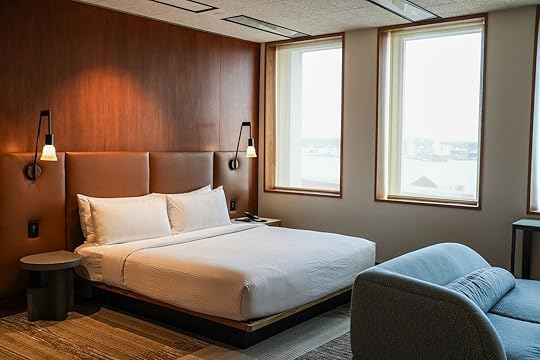
Chairman Suite
Photo: Joanna Kalafatis
Some people think genuine sustainability necessitates sacrificing some level of comfort or luxury. The second I entered my room, one of 165 at Hotel Marcel, I was immediately certain of what I’d always suspected: that line of thinking was wrong.
My deluxe king guest room featured three huge windows, filling the room with natural light. The decor was an attractive mix of retro features, reflecting the building’s 1960s construction, and modern amenities. I had plenty of space to sit, work, and place my things, including a plush green sofa, a window-facing desk with a stylish office chair, a coffee table, and a soft and luxurious king bed. The room was also pet-friendly — great news for my Jack Russell mix Zoe.
Looking out over New Haven’s harbor, I realized that the hotel’s eco-friendly design also enhances the guest experience. Hotel Marcel is the world’s largest Passive House-certified hotel thanks to its energy-saving window design, meaning it adheres to a high international standard for energy consumption and air tightness. That also means that the thick windows completely drown out the noise from the surrounding highways. As a bonus for the hotel itself, the design saves management around $300,000 a year in utility bills.
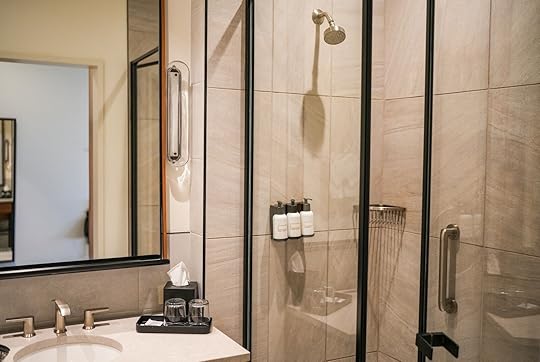
Photo: Joanna Kalafatis
Before exploring the rest of the hotel, I stepped into the bathroom to take a hot shower after my trip. Hotel Marcel is the first US hotel to install the Mitsubishi Heat₂O system, an all-electric system for commercial, high-volume hot water distribution, so visitors can enjoy hot water year-round with no fossil fuel consumption.
As far as other rooms are concerned, you can’t go wrong. All of the hotel’s guest rooms have natural lighting thanks to the interior rooms facing the hotel’s central lightwell. You can choose between two doubles, a king room, two queens, deluxe options for the latter two, a corner king with panoramic views of New Haven’s harbor, or one of the suites.

Chairman Suite
Photo: Joanna Kalafatis
The Chairman Suite is the largest and most luxurious room available. Hotel Marcel is housed in the revamped former Armstrong Rubber Company Building, originally built by legendary architect Marcel Breuers. The Chairman Suites are built in the former company’s sprawling, revamped executive offices. In addition to spacious bedrooms, each includes a kitchenette and living area, all overlooking the Long Island Sound below.
Hotel Marcel also offers an accessible Presidential Suite that’s even larger — 700 square feet. For all of its comfort, my room was accessible in price: deluxe king rooms cost about $150 per night on weekdays and $230 per night on weekends.
Farm-fresh fare: Dining at Hotel Marcel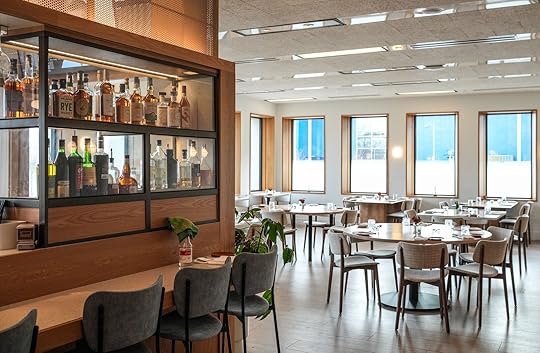
Photo: Joanna Kalafatis
At Hotel Marcel, I managed to keep up my daily routine without leaving the hotel. The hotel has a fitness center, a restaurant, a hybrid cafe and bar adjacent to the restaurant, and my favorite: a comfortable lounge on the ground floor where I could relax with a coffee, work, or read.
The restaurant, BLDG, helmed by rising chef Megan Gill, adheres to the hotel’s eco-friendly philosophy. All ingredients are sourced within 250 miles of the hotel from farms Gill has personally selected, and every dish is made using sustainable energy. When I spoke with Gill, it was clear how much pride she took in using locally produced ingredients to create new dishes that vary with the seasons while showcasing the local produce and animals.
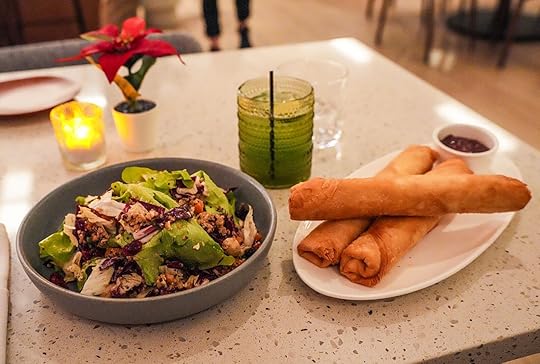
Photo: Joanna Kalafatis
Cider-braised chicken was the star of my three-course meal. I ordered it out of sheer curiosity since I’d never tried anything like it before. Bone-in chicken thighs were dressed with miso caramel and cornbread crumbs, an innovative and delicious combination of flavors. One thing to note is that the portions here are definitely on the larger side; you’ll never leave hungry.
My meal at BLDG was reflective of the general atmosphere at Hotel Marcel — not once did I feel the hotel’s eco-consciousness come at the expense of my experience. If anything, the eco-friendly measures only resulted in benefits. Gill herself told me that locally sourcing food resulted in both cheaper and fresher ingredients for her kitchen — attesting to the fact that it’s possible to create an elevated, amenity-filled hotel that doesn’t harm the planet.
Off the property: Exploring New Haven
Photo: James Andrews1/Shutterstock
I hadn’t visited New Haven for years, so I figured I’d spend some time exploring the town, which is perhaps best known for being home to Yale University. I didn’t have a car, but thankfully Hotel Marcel provides an electric shuttle that takes guests into town to the destinations of their choosing. I called ahead, and within 5-10 minutes, the shuttle was ready.
Naturally, I had to try what New Haven’s second claim to fame is after being home to an Ivy League: pizza. The two most historic pizza places in the area are Frank Pepe and Sally’s. Opened in 1925, Frank Pepe has now been operating for a century. The people who run Sally’s are part of the same family — due to a disagreement decades ago, they broke off and started their own pizza place just down the street.
I stepped into Frank Pepe, under the massive sign featuring a mustachioed Italian man, to order the local favorite: white clam pie. This pizza is the restaurant’s signature offering, and to my surprise, the combination of flavors was infinitely more delicious than I thought it would be.

Photo: f11photo/Shutterstock
For cultural spots in town, try the Yale University Art Gallery or the university’s Peabody Museum of Nature History. On pleasant days, you can explore East Rock Park, a city park that has a great view of the surrounding area from its highest point.
Getting to New Haven and Hotel Marcel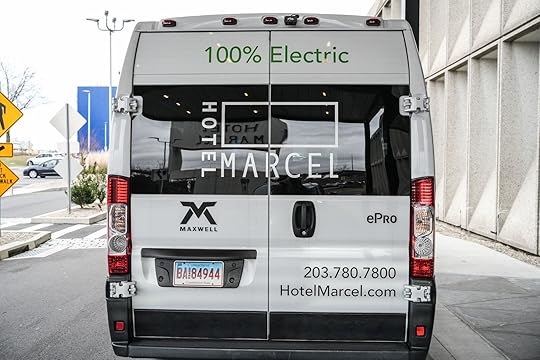
Photo: Joanna Kalafatis
New Haven has a small regional airport. Visitors usually fly into either La Guardia or John F. Kennedy International Airport in New York City. La Guardia is slightly closer, just 74 miles away.
To get to Hotel Marcel from NYC you can take Amtrak from Penn Station or one of the MTA trains. The journey takes 1 hour and 40 minutes. Once you get to New Haven train station, the hotel’s electric shuttle will be waiting to drive you the 1.2 miles to Hotel Marcel.
You can also drive — about a two-hour journey — but I still recommend the train. In addition to avoiding the infamous NYC traffic, it lets you start your journey on an environmentally friendly foot on Amtrak’s electric train. 
January 6, 2025
The Lesser-Known Wildlife Reserve Where In-the-Know Travelers Are Going on Safari

Samburu National Reserve, in the arid, northern parts of Kenya, isn’t anywhere near as well-known as the country’s Maasai Mara National Reserve. In fact, it’s among the least-visited of Kenya’s national reserves, parks, and conservancies. While it’s no secret that safari vacations are growing in popularity, it’s still free from the crowds of other parks — which may be why in-the-know travelers are setting their sites on the gorgeous 64-square-mile park. In 2020, the Maasai Mara saw 15 times the number of visitors of Samburu, and Nairobi National Park saw nearly 50 times as many visitors. Even Lake Nakuru National Park sees more visitors.
But it’s not just the crowd-free experience that makes Samburu special: it’s a group of animals literally called the “Samburu Special Five.” The five unique species are endemic to the region and are extremely rare to see almost anywhere else in Kenya. And when you do see them — which you likely will if you do more than one game drive — you’ll see them in a peaceful environment. Because it has fewer visitors, travelers get the chance to watch wildlife encounters with fewer vehicles crowding the scene.
View this post on Instagram
A post shared by Suzie Dundas (@hikeupyourskirt)
Fortunately, though the crowds are smaller, the lodging options are just as impressive as any other park in the country. I stayed in a suite at Soroi Larsens Camp, which included not just a gorgeous tented room with a private plunge pool, but also a lofted outdoor bed high above the reserve, allowing me to sleep under the stars while listening to the sounds of birds, elephants, and even roaring lions.
I did my Kenya trip with Alluring Africa, an established safari company that plans custom trips throughout Africa. While you certainly can visit Samburu, Larsens Camp, and other parts of Kenya without using a travel company, I appreciated the perks that came with traveling with a company, as well as having someone local to deal with transportation and smaller planning details).
If you’re thinking about planning a safari trip, you certainly don’t want to skip popular destinations like the Maasai Mara or Amboseli — but you will want to add a few extra days to see the landscapes and stunning wildlife within Samburu National Reserve. 

A pair of unique reticulated giraffes in Samburu National Reserve, Kenya. Photo: Suzie Dundas
In Samburu, guides speak about the “Samburu Special Five:” five unique species that are primarily found in the arid northern regions of Kenya, including Samburu National Reserve. That makes it different from places like the more popular Maasai Mara, where the focus is typically on the traditional “Big Five” (lion, leopard, elephant, rhino, and buffalo). Samburu’s version of the big five are the Grevy’s zebra, reticulated giraffe, Beisa oryx, Somali ostrich, and gerenuk.
During my three-day visit, we saw four of the five species every day. The only one we nearly didn’t see was the Somali ostrich, but fortunately, we saw a few on our drive back to the Samburu air strip on our last day, rounding out our sighting of all five rare species.
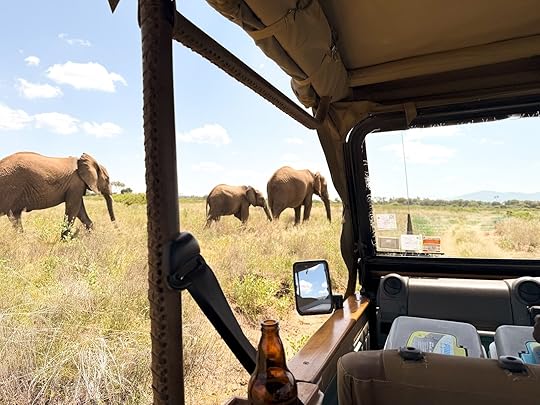
We arrived at Samburu National Reserve after a quick one-hour flight from Nairobi. The team from Larsens Camp picked us up at the air strip (and even met us with cold beers!) On the drive to the camp, we spotted these elephants crossing in front of our open-air vehicle. It was our first sighting and we thought we were so lucky — but we got even luckier, as elephants got this close to our vehicle on nearly every drive. (Photo: Suzie Dundas)

This group of reticulated giraffes (Giraffa reticulata) was slowly making its way through the savannah in Samburu National Reserve as we arrived. The reticulated giraffe is one of the “Samburu Special Five” species and is unique to northern Kenya. They can be up to 18 feet tall and mostly feed on acacia trees.
Reticulated giraffes have a distinctive polygon patterns, with with sharp edges and white lines in between. It looks almost like a net — hence the name “reticulated,” which means net-like. Their populations have declined in recent years due to habitat loss and poaching, making Samburu one of the few places where you’ll all but guaranteed to see one. We saw dozens on every game drive, and I could watch them from my outdoor plunge pool at Soroi Larsens Camp. (Photo: Suzie Dundas)
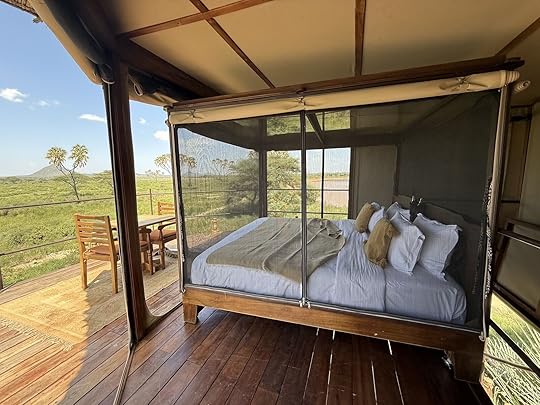
I spent three nights in Samburu at Larsens Camp, a recently renovated tented camp on a river bank. My room was amazing, with a huge four-poster bed, canvas and mesh walls with floor-to-ceiling views, large outdoor living spaces, and even a private plunge pool overlooking the reserve and grazing giraffes. But the best part of the room was this: the starbed.
Totally separate from the room was this raised platform two stories above the reserve. When you want to sleep under the stars, the Larsens Camp staff will move the bed forward and roll back the roof. Though I was there in the rainy season, I had clear skies every night. The mosquito netting works extremely well, and since it’s dark, it doesn’t attract bugs or bats. I didn’t sleep that well, but in the best way possible — it was absolutely delightful to wake up here and there to the sounds of lion roars or elephants trumpeting. Below the lofted bed is an outdoor bathroom, so you don’t have to go back into your actual room all night. (Photo: Suzie Dundas)

I was thrilled to capture this photo of a cheetah (Acinonyx jubatus) in Samburu National Reserve enjoying a recently caught meal in the tall grass. They’re the fastest animals on land, as everyone learns from a young age, and can run up to 70 mph to chase down prey. Samburu provides an excellent habitat for the elegant predators, thanks to its abundant wildlife and combination of open terrain for hunting and shrubby grasslands to hide in while eating. Unlike lions or leopards, cheetahs hunt during the day to avoid competition from nocturnal predators, such as hyenas. But they have to eat quickly: while their lightweight build helps them achieve top speeds, it also means they can easily lose a kill to species like hyenas and jackals.
Spotting a cheetah is somewhat rare in Samburu as their numbers are lower compared to other carnivores in the area — there are only about 10 in the reserve. However, our guide had a wildly good eye for spotting them and knew where they like to hang out, affording us this rare chance to see one up close. (Photo: Suzie Dundas)

It’s always the “Big Five” travelers want to see on safari, but the gerenuk (shown here) was one of my favorite sightings of the whole trip, mostly for their endearingly goofy appearances. It’s called Litocranius walleri but often called a “giraffe gazelle,” for obvious reasons. Its long neck allows for unique feeding behavior (and vice-versa, evolutionarily speaking): it stands on its hind legs to browse from higher branches. That, combined with their small heads, allows them to reach leaves and branches other herbivores can’t.
The gerenuk population has declined about 25 percent in the last decade or so, primarily due to habitat loss and human activities road construction and agriculture, which disrupts their access to food and shelter and makes them more vulnerable to predators. (Photo: Suzie Dundas)

I’ve been lucky enough to do lots of game drives around the world, but aside from in Sri Lanka, I’ve never seen large herds of elephants in such numbers. We saw plenty of baby elephants with mothers, which isn’t unusual, as elephant calves stay with their moms for up to three years. During that time, they learn skills related to navigation and survival. While we were in Samburu, we saw a mother teaching her calf how to swim and wash off in the river, using her trunk to block the playful baby from moving too far down the river. (Photo: Suzie Dundas)

The Grevy’s zebra is the largest and most endangered of the three zebra species. It’s notably different from other species for its thinner, tighter stripes, and fully white belly. It was once widespread across East Africa, but its population has declined to fewer than 3,000 individual animals, with Samburu serving as a critical conservation habitat. In the back is an Beisa oryx, also one of the Samburu Special Five. The two species are often seen in close proximity. (Photo: Suzie Dundas)

This vibrant critter is a flap-necked chameleon, or Chamaeleo dilepis. I’d never seen one in the wild before and didn’t even realize it was a chameleon, until I watched it for a while and noticed it had gone from taupe to green to dark brown once it snuck into the grass. They’re part of a fascinating group of reptiles known for their zygodactyl (bird-like) feet, long prehensile tails that can grip things, and independently rotating eyes, allowing them to look in two directions simultaneously.
In Samburu, sightings aren’t exceedingly common, as they tend to be solitary and secretive, not to mention hard to find. However, during the cooler parts of the day, especially in the morning, you may catch them basking or cautiously crossing open ground, as seen here. I spotted this one crossing the walkway on the way to my room at Soroi Larsens Camp. (Photo: Suzie Dundas)

Warthogs are common throughout Kenya and are called “pumba” in Swahili, which inspired the name of the warthog character in Disney’s “The Lion King.” They’re actually quite cute in person, with fuzzy ears and giant noses that wrinkle when they snort. They’re not hard to spot but can be a bit hard to photograph, since they’re brush-colored and short enough that they’re often obscured by grasses, especially when burrowing. It’s not uncommon for other animals like mongooses to move into warthog burrows once the pumbas have moved on. (Photo: Suzie Dundas)

It’s shockingly easy to photograph reticulated giraffes in Samburu National Reserve. In fact, there were many times when they were too close for me to use my nice DSLR camera, and I had to whip out my iPhone instead. It’s lucky that they’re common in Samburu, as their population has declined by about half in the past three decades. Today, fewer than 16,000 individuals remain in the wild. Many anti-poaching organization throughout the country have focused specially on the species in the last few years, employing locals from nearby communities in conservation and protection efforts. (Photo: Suzie Dundas)

I took this photo of a family of African elephants crossing the Ewaso Ng’iro River from my room at Soroi Larsens Camp. My room was the furthest from the rest of the camp, and included a raised tower with amazing views of both the river behind the resort, and the vast grasslands surrounding the rooms. I saw elephants crossing through the river several times during my short stay, and even had to clean up one of our breakfasts in the bush in a hurry when a large herd decided the sunny clearing we were in looked like a good place to graze for a bit. (Photo: Suzie Dundas)

I’ve never been particularly into birding, but anyone who is knows that birds are extremely difficult to photograph: they’re small, they’re usually far away, and they tend to take off as soon as you begin to get close. But in Samburu, I lucked out, as we were able to get quite close to several birds. This one (a fork-tailed drongo) was only about 10 feet from our safari car. Drongos can mimic other bird calls and even some mammal calls, which can help them steal food or warn about nearby predators. They also tend to follow large herbivores like elephants and zebras, catching insects disturbed by the bigger animals’ movements. (Photo: Suzie Dundas)

Samburu National Reserve is home to around 900 African elephants, giving it one of the most stable populations in Kenya. They’re spotted more commonly in the dry season when they have to travel close to water, but even during the rainy season, we saw dozens every day. But despite their size and strength, they face threats from poaching and habitat loss. However, organizations based in Samburu National Reserve are working on their behalf, such as the Save the Elephants . It was founded in the early 1990s and leads research, tracking, and anti-poaching efforts aimed at protecting the animals. (Photo: Suzie Dundas)

The martial eagle (Polemaetus bellicosus) is Africa’s largest eagle and one of the biggest birds I’ve seen in my whole life. They have a wingspan of up to 8.5 feet and can be nearly three feet tall. Because of their size, they can take down creatures as large as a baby antelope. They’re thriving in Samburu National Reserve, and we saw them a few times on morning game drives perched in trees, watching for potential prey from as far as three miles away. (Photo: Suzie Dundas)

George, shown here hard at work, was our naturalist in Samburu National Reserve who works at Larsen Camp. Aside from being a fun and super-knowledgable person, he was an incredibly impressive guide. His ability to spot animals from afar while driving helped us see species we’d never spot on our own, and he knew every animal, bird, and plant off the top of his head. He also asked us every morning what we wanted to look for and was pretty darn good at delivering. He was a great guide and we wished we could have just had him hang out with us for the rest of the trip, too. (Photo: Suzie Dundas)

This is a lilac-breasted roller and is known as one of the most photogenic birds in Africa — which it certainly is. They get their name from the moves they make mid-air when trying to find mates or fight over territory. Fortunately, it’s a common sight, which makes Samburu a draw for birders and bird photographers, as it’s hard to take a bad photo of the rollers (unless they won’t sit still long enough). (Photo: Suzie Dundas)

The Beisa Oryx is one of the ‘Samburu Special Five,’ and thrives in arid environments, where it can survive on minimal water. It’s rarely seen in other parts of Kenya, making Samburu National Reserve one of the best places to see the unique species. We saw them throughout the park, often near impalas zebras, and other grazing herds. (Photo: Suzie Dundas)
More like thisNewsSleep and Dine With Giraffes at This Giraffe Hotel in Kenya200 United Airlines Planes Will Have Free Internet by the End of 2025

In September 2024, United Airlines announced that it was partnering with Starlink to bring free Wi-Fi to all of its planes, with testing starting in 2025. But only six days into the new year, the airline released an update: The first Starlink-equipped commercial flight will take off this spring on a regional jet — well ahead of schedule.
While the airline will eventually add Starlink to its entire fleet, which consists of more than 1,000 aircrafts, United will first outfit every single one of its two-cabin regional planes. Around 200 regional planes, i.e. 20 percent of the fleet, will have free internet by the end of 2025.
All of United Airlines’ regional jets fly under the airlines’ livery but are operated by partner airlines such as CommuteAir, GoJet Airlines, Mesa Airlines, Republic Airways, and SkyWest Airlines. United Airlines’ regional jets can carry between 50 and 76 passengers only.
To access the free Wi-Fi on board one of United’s regional planes, all you’ll need to do is to sign up for free for the airline’s frequent flyer program, MileagePlus.
Currently, United Airlines charges $8, or 800 miles, for MileagePlus members, and $10 for everyone else, to access Wi-Fi on its domestic flights.
United Airlines promises that the in-flight connectivity will be fast and reliable, allowing passengers to access work documents, use streaming services, shop, play games, and more on their personal devices and on their seatback screens. The airline also promises to roll-out seatback screen for every seat. 
The Most Wish-Listed US Cabins on Airbnb

Few vacations are more relaxing than a cabin retreat. Whether you’re using it as a base for your hiking or skiing excursions, or simply planning to kick back by the fireplace and relax with a book, cabins have a quiet romance about them. It’s no surprise, then, that cabins are among the most popular properties searched for by Airbnb users. The company just revealed its most wish-listed Airbnb cabins in the US, and the list might just inspire you to pull a Thoreau and head to the wilderness. From New York to Washington, these are the most wish-listed Airbnb cabins in the US.
We hope you love the Airbnb cabins we recommend! Just so you know, Matador may collect a small commission from the links on this page if you decide to book a stay. Listed prices are accurate as of the time of publication.
Midcentury cabin near a lake — Hamlin, Pennsylvania
 Photo: Airbnb
Photo: Airbnb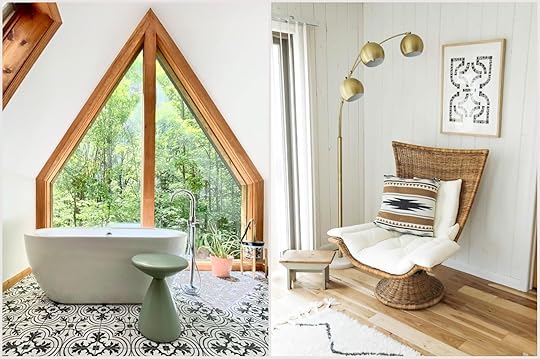 Photo: Airbnb
Photo: Airbnb Photo: Airbnb
Photo: AirbnbSee more photos
An A-frame surrounded by trees in the Pocono Mountains, this Airbnb cabin has a deck with benches and fire pit, and access to a community pool, tennis court, ski hill, and two lakes. There’s also a full chef’s kitchen with hardwood countertops and a dining table that seats six — perfect for larger family gatherings.
Six guests, three bedrooms
Price: $351 per night
 Photo: Airbnb
Photo: Airbnb Photo: Airbnb
Photo: Airbnb Photo: Airbnb
Photo: AirbnbSee more photos
Located right on the edge of the Sierra National Forest and Yosemite National Park — and just 15 minutes from Bass Lake — this A-frame cabin is surrounded by oak, pine, and manzanita trees. Inside you can enjoy the home’s modern design, while a rugged wilderness awaits just outside your window.
Four guests, one bedroom
Price: $266 per night
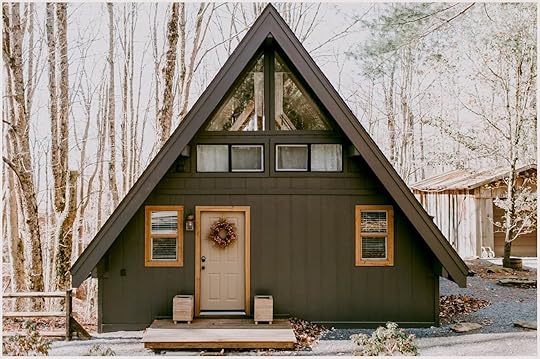 Photo: Airbnb
Photo: Airbnb Photo: Airbnb
Photo: Airbnb Photo: Airbnb
Photo: AirbnbSee more photos
This cabin in the woods of North Carolina comes with a lofted bedroom under a peaked roof, and woodsy furniture that lends to its treehouse-esque atmosphere. There’s also an outdoor swing overlooking a creek, and windows throughout with views of the forest. If you’re looking for a peaceful retreat to get off the grid for a while — this is it.
Four guests, two bedrooms
Price: $207 per night
 Photo: Airbnb
Photo: Airbnb Photo: Airbnb
Photo: Airbnb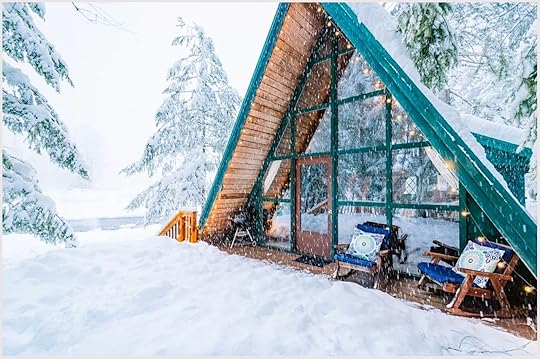 Photo: Airbnb
Photo: AirbnbSee more photos
Located between the Cowlitz River and Coal Creek, this cabin is surrounded by river and mountain views. It has large front and back decks, a fully-stocked kitchen, wood-burning fireplace, and it’s just a short drive to Mt. Rainier National Park and the White Pass Ski Area. The best part is that it’s completely pet-friendly.
Six guests, one bedroom
Price: $329 per night
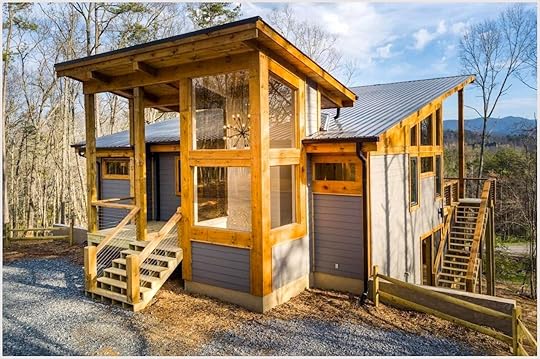 Photo: Airbnb
Photo: Airbnb Photo: Airbnb
Photo: Airbnb Photo: Airbnb
Photo: AirbnbSee more photos
One of the most modern Airbnb cabins on the list, this brand new cabin has a stone-stacked fireplace, hot tub, grill, an expansive deck with plenty of seating, and glass windows pretty much everywhere overlooking the forest. It’s also just three miles from the shopping and restaurants of downtown Blue Ridge, as well as the Blue Ridge Scenic Railway.
Eight guests, three bedrooms
Price: $432 per night
 Photo: Airbnb
Photo: Airbnb Photo: Airbnb
Photo: Airbnb Photo: Airbnb
Photo: AirbnbSee more photos
This secluded cabin overlooks the scenic Shenandoah River and sits right on the edge of the George Washington National Forest. Recently renovated, the cabin features a wood fireplace, outdoor fire pit and hot tub, and wrap around deck. It also has private access to a trail leading to the Massanutten Circuit Trail.
Four guests, two bedrooms
Price: $250 per night
 Photo: Airbnb
Photo: Airbnb Photo: Airbnb
Photo: Airbnb Photo: Airbnb
Photo: AirbnbSee more photos
The Box Hop is a house on 18.5 acres in the Hocking Hills, constructed using three intermodal shipping containers. With a focus on sustainability and modern design, the house is simple and economical in design but has all the amenities you need to be comfortable. In addition to the gas grill and fire table, there’s also a hot tub surrounded by trees and a rooftop patio for sunbathing.

Six guests, three bedrooms
Price: $436 per night
 Photo: Airbnb
Photo: Airbnb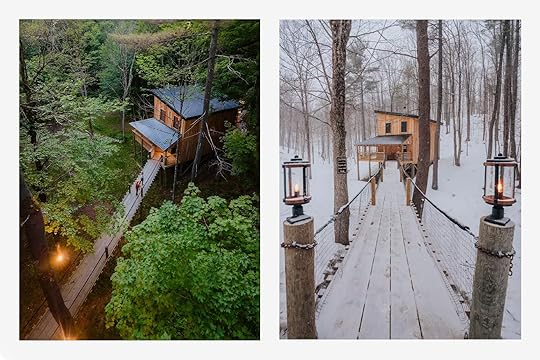 Photo: Airbnb
Photo: Airbnb Photo: Airbnb
Photo: Airbnb Photo: Airbnb
Photo: AirbnbSee more photosA cozy cabin Airbnb and the Adirondack Mountains is a match made in heaven and this getaway has amassed over 500 glowing reviews. Access is via a suspension bridge which creates a whimsical setting – but that’s just for starters. At the rear, you have a porch, pond with a waterfall, and firepit overlooked by the wall-to-wall windows. The interiors compete with a Manhattan condo and there’s a chandelier in the shower.
Four guests, two bedrooms
Price: $610 per night
 Photo: Airbnb
Photo: Airbnb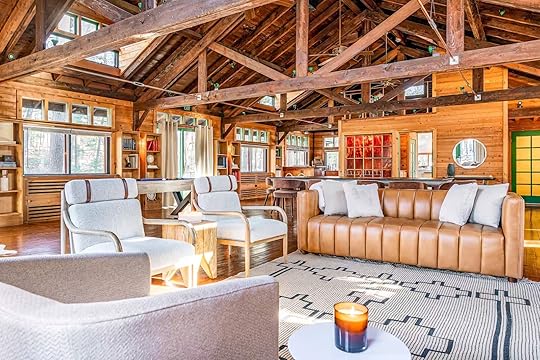 Photo: Airbnb
Photo: Airbnb Photo: Airbnb
Photo: Airbnb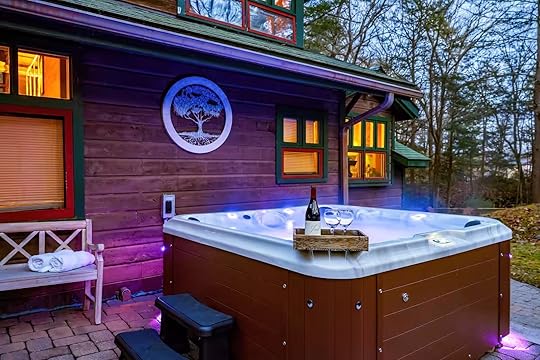 Photo: Airbnb
Photo: AirbnbSee more photosIndulge in the Great Outdoors and plenty of downtime at this pet-friendly Airbnb near the New Jersey and New York borders. Newly added in time for the New Year, the lodge features traditional log cabin decor but enjoys the practicality of a modern kitchen, marble-clad bathroom, and hot tub. It’s designed for a couple although mattresses are available for small group bookings.
Two guests, one bedroom
Price: $207 per night
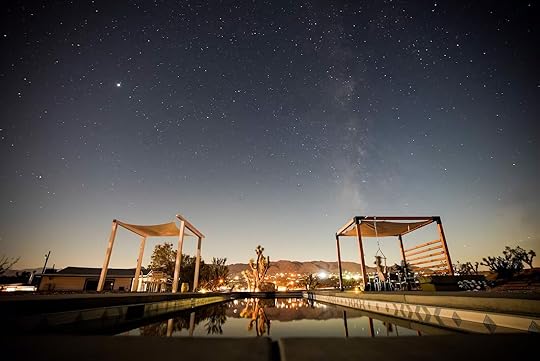 Photo: Airbnb
Photo: Airbnb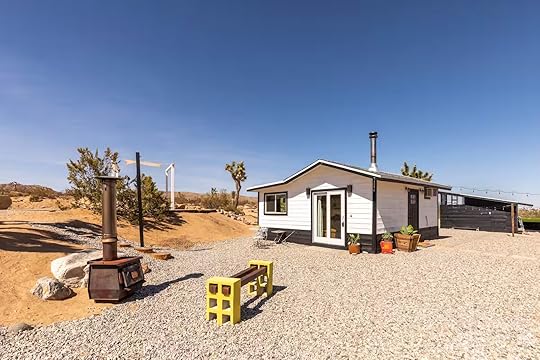 Photo: Airbnb
Photo: Airbnb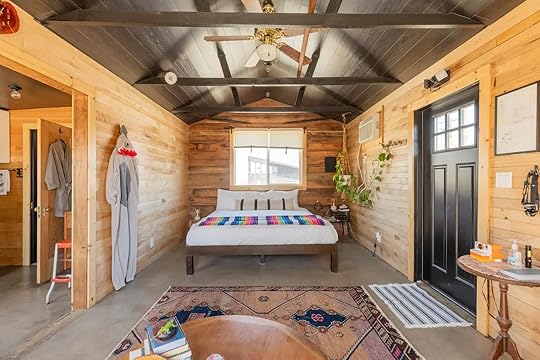 Photo: Airbnb
Photo: Airbnb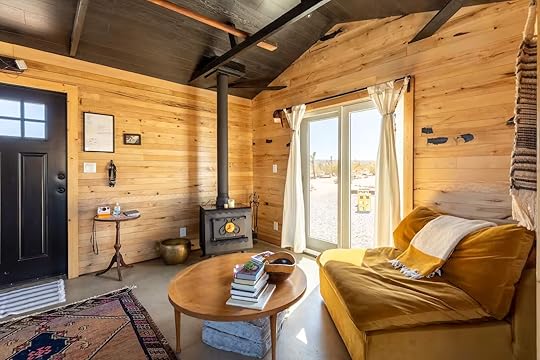 Photo: Airbnb
Photo: AirbnbSee more photosThis cabin Airbnb in the Californian desert has a private hot tub for all seasons and a huge saltwater pool for when the mercury rises. This, the lawn area, and the yard games are shared with one other cabin. The cabana is furnished with a compact kitchen and a retro bathroom with a tub. Besides the log burner, the beds have heated blankets and a novelty onesie is the icing on the cake.
Two guests, one bedroom
Price: $213 per night
 Photo: Airbnb
Photo: Airbnb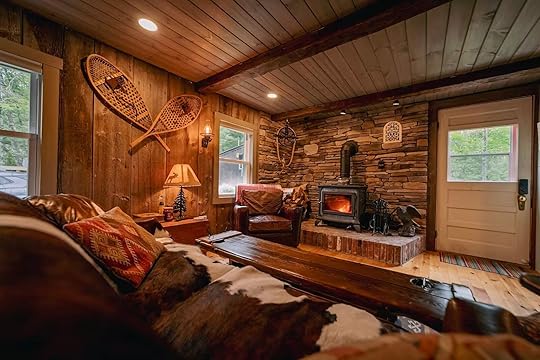 Photo: Airbnb
Photo: Airbnb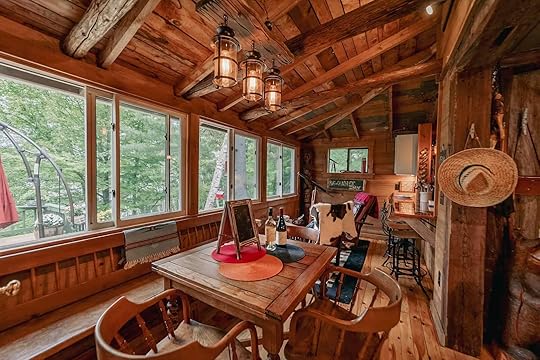 Photo: Airbnb
Photo: Airbnb Photo: Airbnb
Photo: AirbnbSee more photosExperience all the thrills of a summer camp as a family at this gigantic cabin on the banks of Lake Webb. You’ll find kayaks, paddle boards, and a Sunfish tethered to the private dock for use from dawn until dusk, or dusk until dawn. The main cabin is tricked out with vintage knick knacks and guitars. Sleeping quarters are scattered across the cottage and the bunkhouse whereas hardier adventurers can glamp in the boathouse.
Seven guests, four bedrooms
Price: $725 per night
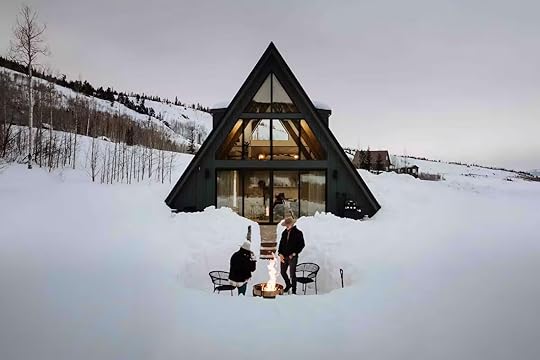 Photo: Airbnb
Photo: Airbnb Photo: Airbnb
Photo: Airbnb Photo: Airbnb
Photo: Airbnb Photo: Airbnb
Photo: AirbnbSee more photosFill your days with hiking, snowshoeing, rafting, and fishing at this backcountry cabin Airbnb in Colorado’s Rocky Mountains. This is a contemporary pad with a minimalist aesthetic and tons of natural light inside and unmatched views from the deck. The principal bedroom roosts on the mezzanine while the bunk room can accommodate four. There’s plenty of space to park a snowmobile or boat trailer.
Six guests, two bedrooms
Price: $280 per night
 Photo: Airbnb
Photo: Airbnb Photo: Airbnb
Photo: Airbnb Photo: Airbnb
Photo: Airbnb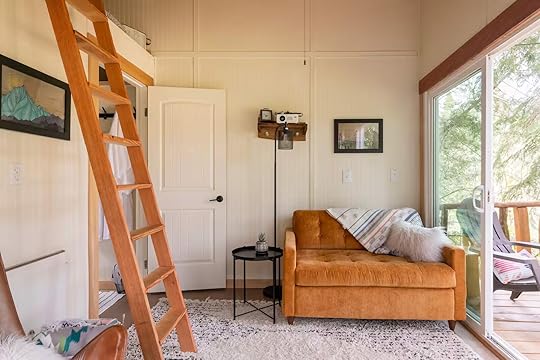 Photo: Airbnb
Photo: AirbnbSee more photosThirty miles east of Seattle, this top-rated Airbnb is perfect for a weekend getaway. The treehouse cabin is buried in the peaceful evergreens of King County and has an outdoor copper tub looking over the forest. See about adding the host’s Mycology Immersion Experience to your booking which includes readings, a sauna, and a charcuterie board of locally foraged mushrooms.
Two guests, one bedroom
Price: $280 per night
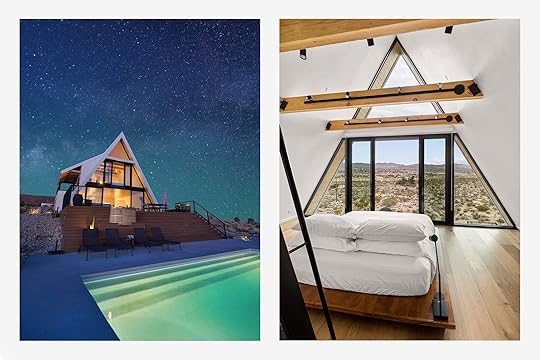 Photo: Airbnb
Photo: Airbnb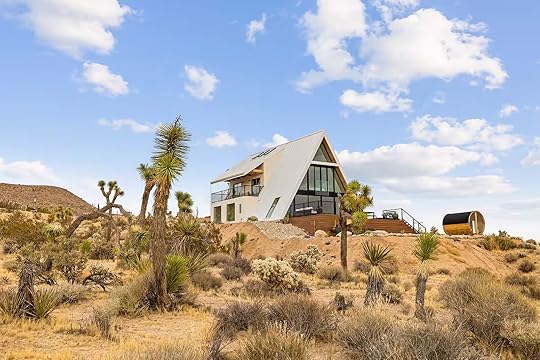 Photo: Airbnb
Photo: Airbnb Photo: Airbnb
Photo: Airbnb Photo: Airbnb
Photo: AirbnbSee more photosThis cutting edge cabin oasis has a cedar soaking tub and sauna plus a salt water pool. The views go on for days and you’ll be spoiled rotten by the sunrises, sunsets, and stargazing potential – whether from bed or the backyard. There’s a multiple-choice coffee station and every piece of tech is accounted for from the Sonos sound system to the EV charger. Yucca Valley and Joshua Tree are 10 minutes away.
Eight guests, four bedrooms
Price: $675 per night
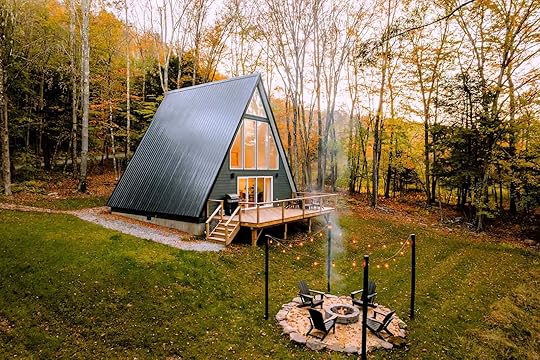 Photo: Airbnb
Photo: Airbnb Photo: Airbnb
Photo: Airbnb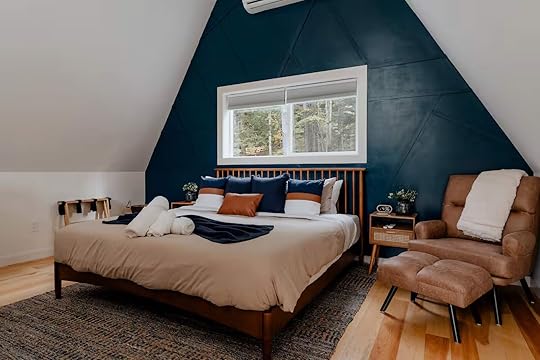 Photo: Airbnb
Photo: Airbnb Photo: Airbnb
Photo: AirbnbSee more photosDetox from a busy holiday season at this Guest Favorite Airbnb in Upstate New York on a six-acre plot. The A-frame cabin has two double bedrooms and an open-plan lounge with a fully equipped kitchen. Time at the chalet can be split between sipping coffee on the deck, sharing ghost stories around the fire pit, and de-stressing in the barrel sauna. The host can connect you to a fly fishing guide and you’re welcome to roam the private forest.
Four guests, two bedrooms
Price: $209 per night
 Photo: Airbnb
Photo: Airbnb Photo: Airbnb
Photo: Airbnb Photo: Airbnb
Photo: Airbnb Photo: Airbnb
Photo: AirbnbSee more photosLocated minutes from the Kingdom Trail network, this adorable New England Airbnb is equally popular with bikers as road trippers. The back porch is festooned with fairy lights and there’s a fire pit down below, with both seating areas providing epic views. The dog-friendly cabin is stocked with board games and locally sourced amenities including bathing products and coffee.
Four guests, three bedrooms
Price: $288 per night
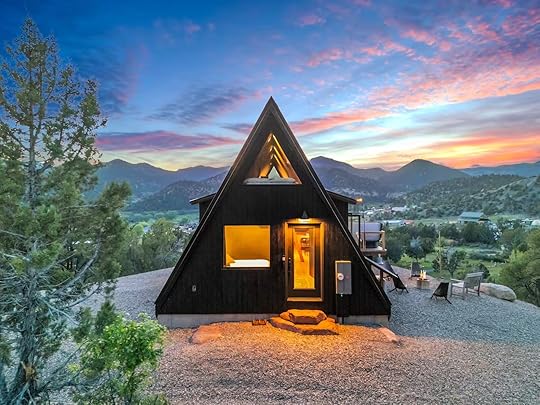 Photo: Airbnb
Photo: Airbnb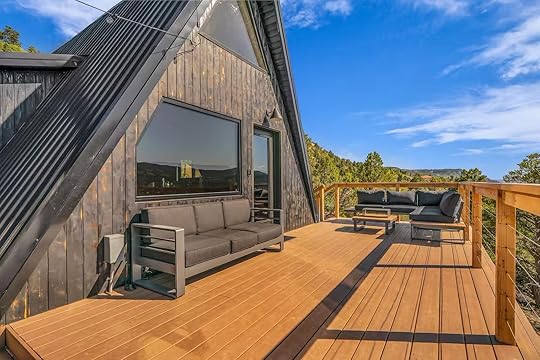 Photo: Airbnb
Photo: Airbnb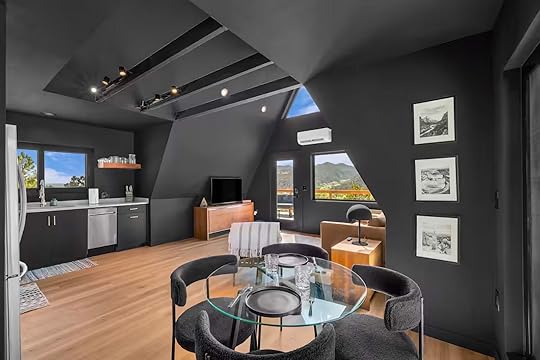 Photo: Airbnb
Photo: Airbnb Photo: Airbnb
Photo: AirbnbSee more photosThis pet-friendly Airbnb near Zion and Bryce Canyon national parks provides a convenient base in the heart of the Utah wilderness. A day of hiking can be rounded off with a long soak in the hot tub – the sunset views make it worth getting wrinkled fingertips. The onyx color scheme brings an unexpected twist to typical cabin decor evenings whereas the host’s commitment to quality guarantees a comfortable night’s sleep.
Six guests, two bedrooms
Price: $293 per night
January 3, 2025
The Best Night Sky Events, Festivals, and Celebrations Worth Traveling for in 2025

Astronomy enthusiasts and travelers who love marveling at the night sky will find no shortages of astronomy events worth traveling for in 2025. Not only will there be a double lunar eclipse, but it’s also expected to be the peak of an 11-year solar cycle, in which sunspot numbers, solar flares, and coronal mass ejections are exceptionally high — which means brighter and more frequent aurora borealis, or northern lights, displays.
From the deserts of Utah to the pristine wilderness of Canada, there are plenty of place to go to either watch night sky events on your own, or celebrate with hundreds of other enthusiastic stargazers. In 2025, you could attend lectures and presentations from astronauts, learn to take dazzling photos of the stars in an astrophotography class, or visit a national park and use a high-powered solar scope to see the sun like never before.
To help with your night sky trip planning, Matador Network rounded up not just the astronomical phenomena worth traveling for in 2025 but also the best night sky events and national park stargazing festivals happening in the coming year.
In a year full of significant astronomical phenomena, these are the festivals and night sky events that stand out, each promising an experience that is as much about place as it is about the magic above.
We hope you love the spaces and stays we recommend! Just so you know, Matador may collect a small commission from the links on this page if you decide to book a stay. Listed prices are accurate as of the time of publication.
Jump to:The 10 best astronomy events in 2025 worth traveling forThe best astronomy events at national parks worth the travelGlobal astronomy festivals events to attend in 2025The 10 best astronomy phenomena worth traveling for in 2025The year 2025 promises to be a remarkable one for night sky enthusiasts, offering a lineup of celestial events that will captivate stargazers around the world. Not only is it the maximum of Solar Cycle 25 (making it an excellent year for aurora chasing), but eclipses will also take center stage. Two lunar eclipse in spring and fall will drape the Moon in a coppery-red hue, and travelers will be able to see meteor showers such as the Perseids in August and the Geminids in December without much moonlight, making for excellent meteor-watching conditions.
March 14: Total Lunar Eclipse (Blood Moon)

Photo: Hyserb/Shutterstock
Recommended viewing location: Atacama Desert, ChileWhere to stay: Hotels in San Pedro de AtacamaThe Blood Moon on March 14, 2025, is shaping up to be the best lunar eclipse of the year and a must-see event for skywatchers. A Blood Moon occurs during a total lunar eclipse, in which the Earth’s shadow completely covers the Moon. This gives the Moon a deep red or orange hue. What makes the March event particularly special is its timing, visibility, and ideal viewing conditions.
Unlike other lunar eclipses later in the year, the March 2025 Blood Moon will be perfectly visible across the Americas, Europe, and parts of Africa, allowing a large portion of the world to experience it in its entirety during convenient evening hours. Totality (when the Moon is fully in Earth’s shadow) will last for approximately 1 hour and 12 minutes, making it an extended and dramatic celestial show.
It will be at a relatively high altitude during totality for many observers, meaning it will appear larger and brighter than usual. Atmospheric conditions in March also tend to mean clear skies in many regions, and this Blood Moon will be easily visible to the naked eye – though a pair of binoculars or a small telescope will show more detail.
For optimal viewing, head to a dark-sky destination away from city lights. For a truly epic view, consider taking a trip south to the Atacama Desert in Chile, where stargazing tours with experts are readily available. You’ll find stargazing tours that leave from the town of San Pedro de Atacama, but nearly every hotel in the Atacama Desert will offer on-site stargazing, as it’s widely considered one of (if not the) best night sky-viewing destinations on the planet.

Photo: Lillian Tveit/Shutterstock
Recommended viewing location: Iceland or NorwayWhere to stay: The best Airbnbs in Lofoten Islands, Norway; The best northern lights Airbnb in IcelandA partial solar eclipse occurs when the Moon passes between the Earth and the Sun, but only partially covers the Sun (as seen from certain locations). The shadow creates a striking effect where a portion of the sun appears to have a “bite” in it, creating an eerie dimming of natural light in the middle of the day. Partial solar eclipses happen more often than total solar eclipses, but they’re still impressive to see.
If you want to witness this event, you’ll need proper solar viewing equipment, such as eclipse glasses or a telescope with a solar filter. Never attempt to look directly at the Sun without the right protective tools, as it can cause permanent eye damage.
Late March’s particular eclipse will be best visible across parts of Northern Europe, Iceland, and Western Asia, where observers can experience as much coverage as possible. In these regions, up to 40-60 percent of the Sun will be obscured by the Moon.
Late March often provides relatively clear skies in higher latitudes like Iceland and Norway, as well as the chance to catch the Aurora Borealis (northern lights), which are usually still active in March. One of the best places to witness the partial eclipse (and easiest places to reach) is Iceland, especially in the southern parts of the country (Hotel Ranga has the country’s only public observatory, as well as a northern lights wake-up call). The Lofoten Islands in Norway could also be a good pick, and plenty of evening stargazing tours are available from tourist towns like Svolvær.

Photo: Lillian Tveit/Shutterstock
Recommended viewing location: Joshua Tree National Park, CaliforniaWhere to stay: The best Airbnbs in Joshua Tree, the best Joshua Tree Airbnbs for families and groupsThe Lyrids Meteor Shower is one of the oldest known meteor showers, with observations dating back over 2,600 years. It happens in late April and is caused by Earth passing through a debris field left from the Thatcher comet, which passed through the solar system in 1861. When the debris enters our atmosphere, it burns up and creates bright streaks of light across the night sky.
The 2025 Lyrids show will peak on the evening of April 22, going into the early morning on April 23. In ideal conditions, you could see up to 20 meteors per hour. Fortunately, the Moon will be in a waxing crescent phase, setting early and leaving the skies dark for prime viewing.
The Lyrids are known for brief but vivid bursts, occasionally producing meteors with bright trails that linger in the sky for several seconds. Meteors can appear in any part of the sky, though the shower radiates from the constellation Lyra (hence the name). The Lyrids are best observed with the naked eye, as telescopes and binoculars will limit your field of vision. You may want to spring for an ultra-luxe stargazing camp chair before April, as you’ll want to stare at the sky for 20 to 30 minutes to let your eyes properly adjust to the darkness.
The best spots to view the meteor shower will be anywhere with dark skies in the mid-latitudes (not too high in elevation), as that will afford the best vantage point of Lyra. Joshua Tree National Park in California checks all those boxes, and also offers perfect weather in mid-spring.

Photo: PhotoChur/Shutterstock
Recommended viewing location: Denali National Park, AlaskaWhere to stay: The best Airbnbs within driving distance of Denali National ParkOkay, it’s not a night sky event, but it’s definitely worth making travel plans around it. June 21 marks the point when the sun is at its northernmost point in the sky, signalling the official start of summer in the Northern Hemisphere (and start of winter in the Southern Hemisphere). It also makes it the longest day of the year for those north of the equator, and it’s been a reason to celebrate for centuries around the world.
In Scandinavia, Midsummer festivities will light up the countryside, with bonfires, flower crowns, and traditional dances. Iceland’s capital, Reykjavik, is known for its Solstice Festival, where music performances and art installations stretch well into the endless daylight of the Midnight Sun. In England, thousands will gather at Stonehenge to witness the Sun’s rays pierce through the ancient stones.
Travelers looking to make the most of maximum daylight hours should consider outdoorsy destinations with rich natural beauty, especially for anyone planning to camp, glamp, or stay in an eco-lodge. Alaska’s Denali National Park will be one of the best places in the world to revel in near-continuous sunlight. The sun will rise at 3:55 AM on June 21 in Denali, and set at approximately 12:30 AM the following morning, making it an ideal time for hiking, wildlife viewing, and photography in the park. The park’s 49th State Brewing usually has a solstice party, too.

Photo: AstroStar/Shutterstock
Recommended viewing location: Any dark sky areaWhere to stay: The best Airbnbs for stargazing across the USIn mid-August, the two brightest planets in the sky will appear exceptionally close together, at least from our perspective on Earth. It’s a result of their orbital paths aligning in such a way that they look to us like one single bright point of light.
On August 12, you’ll want to look toward the west shortly after sunset. If you can see two separate lights, Venus will be the brighter of the two, with a characteristic silvery-white glow, while Jupiter will appear slightly dimmer and be a warmer hue. You’ll be able to see it without a telescope, though if you have one, you may be able to see the planets in more detail, potentially even seeing Jupiter’s largest moons (it has 95 of them).
For the best experience, astronomers recommend finding a location with minimal light pollution and an unobstructed view of the horizon. It may be a good day to do a summer camping or backpacking trip to one of the country’s best night sky campgrounds, as there’s no one geographic location that’ll be better than another, as long as the weather and light conditions are correct.

Photo: Jan Garbers/Shutterstock
Recommended viewing location: Great Basin National Park, Acadia National ParkWhere to stay: The best Airbnbs around Acadia National ParkThe Perseid Meteor Shower will peak on the night of August 12 and into the early hours of August 13. Expect a high rate of bright, fast-moving meteors that originate from the debris trail left by the Swift-Tuttle comet.
In 2025, the Perseids will benefit from nearly ideal conditions, with the Moon only at about 19 percent illumination. So the sky will be mostly free of moonlight during the peak of the shower, allowing night sky watchers to fully appreciate the event’s brilliance. In ideal conditions, you can see up to 100 meteors per hour at the shower’s peak. Most will be fast and quick, but some could have long, persistent trails (or burst into fireballs). The meteors will be visible across most of the sky, but will be centered around the Perseus constellation to the northeast. Patience is key, as the shower’s activity fluctuates over the course of the night.
As with the conjunction of Venus and Jupiter, anywhere with wide-open views and minimal light pollution should be good. West Coasters may want to head to Nevada’s remote Great Basin National Park, one of the few national parks in the west where you can always get a campsite, even on peak summer weekends (and the Great Basin Star Train is pretty cool, too). East Coasters should make reservations as soon as possible to stay near Acadia National Park in Maine, as the park’s clear summer skies make it a popular spot for night sky viewing.

Photo: Caroline Elliott/Shutterstock
Recommended viewing location: East Africa, northern India, deserts in the Middle EastWhere to stay: The best Airbnbs around Acadia National ParkYou’ve got plenty of time to make travel plans to catch the September total lunar eclipse – and that’s a good thing if you live in North America, since you’ll have to travel to see it. During this eclipse, the Earth will align perfectly between the Sun and the Moon, creating a reddish “blood” hue caused by Earth’s atmosphere scattering sunlight.
This eclipse will be visible across Europe, Africa, Asia, and Australia. Observers in those parts of the world will have the best views, with the total phase of the eclipse lasting approximately 1 hour and 25 minutes. National parks and remote wilderness areas in East Africa will have a great view, such as the Serengeti in Tanzania or the Maasai Mara in Kenya. Most of India will have a perfect view, but you’ll want to go somewhere without much light pollution, like Ladakh, in northern India. In the Middle East, destinations include the Al Hajar Mountains in Oman or AlUla in Saudi Arabia, which is the continent’s first official dark sky park (and has some of the coolest desert hotels in the world).

Photo: ZinaidaSopina/Shutterstock
Recommended viewing location: Anywhere known for the northern lightsWhere to stay: Köngäs in Finland, Hotel Ranga in Iceland, The best northern lights Airbnbs, the best Airbnbs in Alaska2025 is expected to be a significant year for viewing the aurora borealis, or northern lights. They’re tied to an 11-year solar cycle that affects the frequency and intensity of auroras. In 2025, the Sun will be approaching the peak of the solar cycle (called the “solar maximum,”) through late 2025 and into early 2026. During that time, the sun produces more intense bursts of energy and charged particles that interact with Earth’s magnetic field, causing the streaks of color through the sky. When that activity intensifies, the region in which the aurora is visible expands, making the northern lights visible in destinations further south than normal.
Travelers can take advantage of that by traveling in 2025 to places known for aurora viewing, where your chances of seeing them are higher, even if you can only spend a night or two looking up. Regions like Alaska, Canada, Iceland, Norway, Sweden, and Finland are all known for exceptional viewing. But it’s possible that areas further south, like parts of Scotland or the northern United States, may be able to see auroras during the strongest geomagnetic storms. Keep an eye on NOAA’s Aurora Tracker to stay up to date. In 2025, October will likely be the best time to see them, when Earth’s orientation enhances geomagnetic activity.
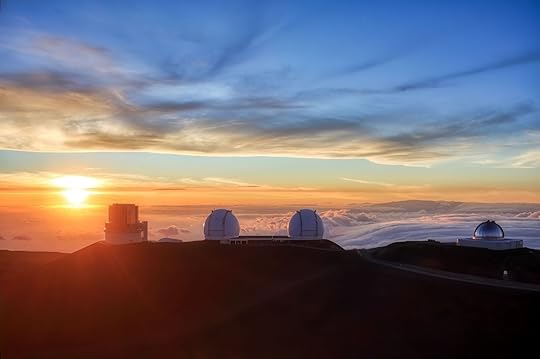
Photo: Izzet SaferM/Shutterstock
Recommended viewing location: Mauna Kea, HawaiʻiWhere to stay: The best Airbnbs on Hawaii’s Big Island“Saturn’s Rings Edge-On” refers to a phenomenon that occurs approximately once every 15 years, when Saturn’s rings appear to vanish or nearly disappear when viewed from Earth. This happens because Saturn’s rings are incredibly thin (only about 10 meters thick) relative to their expansive diameter (more than 270,000 kilometers). During this event, the rings are oriented on an edge to our line of sight from Earth.
The rings become extremely difficult to see with telescopes, giving the appearance of a nearly ring-less Saturn. It occurs twice every year it happens, and this year, amateur astronomers can see it in March and November. However, Saturn will be behind the sun on March 12, 2025, meaning it’ll be difficult to see. So late November is actually a better chance.
You’ll need a decently high-powered telescope to see it, and as usual, will want a destination with a high altitude, dry climate, and clear skies. We recommend heading to the Mauna Kea Observatory on the Big Island in Hawaiʻi. The actual observatory is closed to the public, but the welcome center isn’t. If you have your own telescope, you can visit for the nightly stargazing sessions. If you don’t have a telescope, consider registering for the March or November monthly stargazing events.

Photo: Take Photo/Shutterstock
Recommended viewing location: Sedona, AZWhere to stay: The best Sedona Airbnbs with incredible access to the outdoorsThe Geminids Meteor Shower is reliably one of the most spectacular celestial displays of the year and should peak on the night of December 13 into the morning of December 14. The shower originates from the debris trail of 3200 Phaethon (an asteroid, not a comet), and often produces up to 120 meteors per hour under ideal conditions. The streaks are often in vibrant colors of yellow, green, and blue, and move slower than other meteor showers, making them easier to observe.
The 2025 Geminids will take place during favorable conditions, when the waning crescent of the Moon will create minimal light interference. The show will likely not really get going until at least 10 PM, when the point the meteors originate from (called a “radiant”) is at the highest point in the sky.
To fully enjoy the Geminids, stargazers should find a viewing location far from city lights, ideally in the Northern Hemisphere. The desert surrounding Sedona, AZ, could be a great spot, particularly around the Fay Canyon Loop and Two Trees Observation Area (and the weather in December in Sedona is pretty darn nice, too).
Night sky events in national parks worth traveling for
Photo: sripfoto/Shutterstock
Night sky events and festivals at national parks offer a rare opportunity to connect with the cosmos while surrounded by some of the US’s most breathtaking landscapes. Many national parks are also official Dark Sky Parks, offering clear skies free from urban light pollution.
Some events are hosted by national parks and include just activities, while others are multi-day events hosted at hotels and resorts just outside park boundaries. At most national park night sky festivals, attendees can use high-powered telescopes guided by experts, and sign up for evening activities like night hikes and walks. Many festivals also include educational presentations led by astronomers, scientists, park rangers, and guest speakers, diving into topics like astrophysics, the history of constellations, and the importance of preserving dark skies. Workshops on astrophotography and constellation viewing are usually available, and often, there are daytime activities for families, like art classes and kid-friendly crafts.
If you can’t travel to one of the astronomy festivals in national parks listed below, try checking the park website’s event calendar anyway. Many of the parks below have astronomy-focused events through the year, like outdoor lectures and full moon walks.

Photo: Death Valley National Park/Public Domain
Dates: February 21–23, 2025Location: Death Valley National Park, California/NevadaTicket cost: Free with park admissionKnown for its unparalleled dark skies, the Death Valley Dark Sky Festival offers a weekend of celestial wonders in one of the best stargazing locations in the US. Each night features expert-led astronomy programs, including telescopes to see views of planets, star clusters, and nebulae. Educational presentations delve into astrophysics, the history of the cosmos, and the importance of preserving dark skies, and for those wanting an immersive or more active experience, guided hikes under the stars offer the chance to explore the unique landscape illuminated by starlight. Family-friendly activities like interactive workshops and constellation storytelling in the early evening make it accessible for all ages.

Photo: Alexey Suloev/Shutterstock
Dates: June 21-28, 2025Location: Grand Canyon National Park, ArizonaTicket cost: Free with park admissionSpanning both the South and North Rims, the Grand Canyon Star Party offers a full week of night sky exploration each June. Amateur astronomers set up telescopes for public use, giving visitors a chance to observe celestial objects up close. Nightly presentations by experts provide context to what you’re seeing, from the rings of Saturn to distant galaxies. Supported by astronomy groups as well as the national park itself, the event is as much about education as it is just taking a moment to look up.
There is a host of new exciting glamping lodges around the Grand Canyon, many of which have a focus on stargazing, so 2025 could be an ideal year to attend this fan-favorite park event. Night sky viewing usually happens from around 9 to 11 PM, so you’ll have plenty of time to hike or play outdoors during the day.

Photo: Colin D. Young/Shutterstock
Dates: June 25–28, 2025Location: Bryce Canyon National Park, UtahTicket cost: $100 for one person, $165 for twoSet in the dramatic landscapes of Bryce Canyon National Park, ASTROCON 2025 is a popular event for avid stargazers and amateur astronomy enthusiasts. It’s organized by the Astronomical League and includes talks and workshops led by experts in the field. A large component of ASTROCON is photography and art, and attendees can take classes ranging from beginner astrophotography to journaling to night sky sketching. Most events are held in and around Bryce Canyon National Park, but the actual event is headquartered at Ruby’s Inn, just a mile or so from the park entrance. Discounted room rates are available if you don’t want to get your own place in the desert.
Badlands Astronomy Festival
Photo: Wick Smith/Shutterstock
Dates: July 18-29, 2025Location: Badlands National Park, South DakotaTicket cost: Free with park admissionThis astronomy festival is held against the dramatic backdrop of the otherworldly formations of the Badlands, with telescope viewing and expert-led evening presentations by the National Park Service Night Sky Program, plus guest astronomers. Daytime activities at the Badlands Astronomy Festival usually include interactive workshops and solar observation programs, and at night, stargazers can join constellation tours and night sky photography sessions. The festival highlights the importance of preserving natural darkness and is a unique way to spend time in the landscape at night. If you’ve never considered taking a trip to Badlands National Park, 2025 may be the year to reconsider that. It’s rarely ever crowded, and is know for being one of the most suprising parks to visitors — in a good way — in the entire national park system.
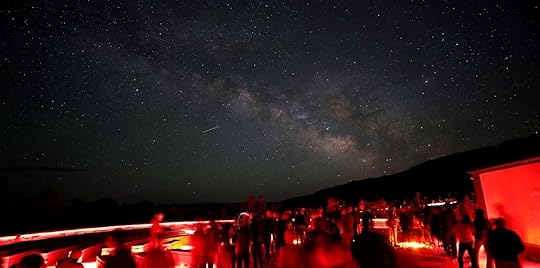
Photo: Great Basin National Park Astronomy Festival
Dates: September 18–20, 2025Location: Great Basin National Park, NevadaTicket cost: Free with park admissionIt’s hard to say enough good things about how amazing the night sky is at Great Basin National Park — or how welcome it can be to find a national park in the middle of summer that doesn’t have crowds. That said, you’ll probably want to reserve a campsite if you visit during the Great Basin Astronomy Festival, as it’s well-known for being one of the best in the country.
It combines both of those selling features, taking advantage of its designation as an International Dark Sky Park with stargazing events, astronomy 101 presentations, and telescope access for attendees. Workshops on night sky photography and constellation tours give visitors a chance to learn hands-on skills, and days are filled with opportunities to use solar scopes and activities for kids and families. Great Basin’s remote location guarantees a pristine view of the Milky Way, perfect for both casual observers and astrophotography enthusiasts, even without any telescopes or tools. You can also tour the Great Basin Observatory during the festival, though you’ll need a separate reservation for that (so keep an eye on the event website to see when registration begins.)

Photo: Theodore Roosevelt National Park/NPS/Jeff Zylland
Dates: September 19-21, 2025Location: Theodore Roosevelt National Park, North DakotaTicket cost: Free with park admissionThe Dakota Nights Astronomy Festival is a family-friendly festival with a focus on STEM, including including rocket building and launching, solar system hikes, and evening telescope viewings. Presentations by nationally recognized speakers and NPS rangers provide insight into astronomy and the importance of preserving dark skies, and with its vast prairies, minimal light pollution, and clean air (for now), Theodore Roosevelt National Park offers a serene setting for stargazing. It’s about a five-hour drive from Badlands National Park in South Dakota, if you want to combine the two.
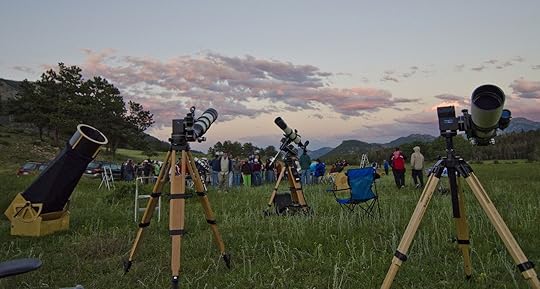
Photo: Rocky Mountain National Park/Public Domain
Dates: TBD (late July or early August)Location: Rocky Mountain National Park, ColoradoTicket cost: Free with park admissionThis festival celebrates Rocky Mountain National Park’s commitment to preserving natural darkness and includes activities like stargazing sessions with telescopes, educational programs, and talks by professional astronomers. The park’s high-altitude location ensures some of the clearest night skies in the country, perfect for spotting distant galaxies or meteor showers. The festival is possible thanks to efforts from a team dedicated just to ensure light pollution stays away from the popular national park, called Defenders of Darkness.
If you can’t make it to festival, another night sky event in 2025 you may want to attend in Colorado is the park’s annual Night Sky Photography Class in September, hosted by the Rocky Mountain Conservancy.

Photo: Shawn.ccf/Shutterstock
Dates: OctoberLocation: Jasper National Park, Alberta, CanadaTicket cost: Priced per activity, ranging from free to $119 CADThis night sky festival is always one of the biggest in North America, celebrating astronomy, science, and the natural beauty of one of the world’s largest accessible dark sky preserves. It runs for two or three weeks, with a mix of both the usual stargazing programs (like nighttime lectures, guided stargazing, and yoga under the stars), as well as more community-focused events in the small town of Jasper. That includes night sky painting classes, symphonies under the stars, astronomy-themed improv shows, “After Dark” trivia, solar scope sessions, and much more. Rather than buying one ticket for the festival, you’ll just buy tickets for whatever event(s) you want to attend. Jasper gets busy (not as busy as nearby Banff, but still busy) so try to make your hotel or campground reservations as far in advance as possible.
Major astronomy events and festivals around the world in 2025
Photo: JakubCervenka/Shutterstock
You don’t have to wait for a celestial event to start staring at the sky — or to start celebrating how amazing our planet is after dark. There are hundreds of night sky festivals and astronomy parties around the world each year, and 2025 is no exception.
If you just want to attend a festival for a few hours and see what the night hype is all about, do an online search for parks around you, and check their events calendars. Many state parks have amazing local stargazing programs, and universities, observatories, and museums often also host single-day events. But if you’ve got the travel bug and want to take advantage of new flight routes and amazing new hotels around the world, consider planning travel around one of the epic stargazing festivals of 2025 below.

Photo: Valine Kobasic/Shutterstock
Dates: April 24-26, 2025Location: Keweenaw Dark Sky Park, MichiganTicket cost: $250 (plus lodging)The annual Upper Peninsula Dark Sky Festival in Michigan falls smack in the middle of International Dark Sky Week, scheduled for April 21–28, 2025. It’s a week when groups around the world work to raise awareness about light pollution and the importance of protecting natural nightscapes, led by DarkSky International.
Michigan’s 2025 dark sky festival will be based at Keweenaw Mountain Lodge, inside the Keweenaw Mountain Dark Sky Park. Registration includes access to all the events as well as hosted lunches on Friday and Saturday, but you’ll need to book your lodging separately (either at the lodge, or a home rental nearby). The full event schedule for 2025 hasn’t been announced, but 2024’s event included guided stargazing, a full calendar of daytime lectures and classes, and outdoor events after dark. The UP (Upper Peninsula) has some of the darkest skies in the US, and is one of the few places in the US where you can see the northern lights with some regularity. So even if you can’t travel to attend the April 2025 dark sky event, you may want to consider booking a trip later in 2025, especially as the aurora borealis is expected to peak this year.

Photo: Jacinto Marabel Romo/Shutterstock
Dates: April 25-29, 2025Location: Canary Islands, SpainTicket cost: FreeThe Starmus Festival (a combination of “stars” and “music”) is a global celebration of science, art, and music. It’s attended by the greatest minds in all three disciplines, including Jane Goodall, Brian May, Nobel Laureates, and astronauts like Chris Hadfield and Anousheh Ansari. The event has two Starmus Camps in Santa Cruz de La Palma and Los Llanos de Aridane, each with space for exhibitions, workshops, shows, music, and performances. There’s also a four-day program of keynote speeches and panel discussions featuring some of the world’s most renowned scientists, but the attendance capacity is limited, so you’ll have to apply to attend. However, everything else is open to anyone who wants to attend, and those lectures are live-streamed at the camps.
Hanging out and attending the events at the camps is completely free, but you’ll need to plan your own lodging around La Palma, as that’s not part of the camp experience. More event details (as well as registration info) should be coming in January 2025.
Vegkop Star Party
Photo: Thammanoon Khamchalee/Shutterstock
Dates: April 25-29, 2025Location: Heilbron, South AfricaTicket cost: R50 (about $3) to attend, plus camping feesThe Vegkop Star Party is an annual gathering of astronomy enthusiasts in Heilbron, South Africa (about a 90-minute drive south of Johannesburg). That part of the country is renowned for its pristine dark skies, offering an excellent environment for stargazing and astrophotography. The party takes place over a long weekend and is hosted at a campground, ensuring attendees are fully immersed in nature. Campgrounds are inexpensive — usually around $15 USD per night.
Evening stargazing sessions are the highlight, and veteran attendees usually set up telescopes and are happy to share their expertise and discoveries. For beginners, experienced volunteers are on hand to assist with telescope setup and provide guidance. During the day, there are workshops and presentations led by experts in the field. Because of the event’s location, it would tie in well with a longer safari or wildlife focused trip to South Africa. You could either grab a quick flight or make the drive to Kruger National Park (about four hours) or visit any of the game reserves closer to the city. You’ll also find lots of multi-day wildlife and safari tours that leave from Johannesburg, in case you don’t want to bother with driving.

Photo: Smithsonian Institute/Public Domain
Dates: Usually the Saturday before/after the summer solsticeLocation: Washington, DCTicket cost: FreeThe Astronomy Festival on the National Mall is an annual event in Washington, DC, held in partnership with Hofstra University. Unlike many other 2025 astronomy festivals, this one has a huge daytime component. The festival features solar, optical, and radio telescope observations; hands-on activities; demonstrations; and opportunities to interact with astronomers on the National Mall. It’s part of the Smithsonian Solstice Saturday, when many of the most popular museums in DC stay open late and host additional events and programming. There are dozens of events, some of which require registration, so bookmark the event’s website if you plan to attend.
If you want to visit the National Air and Space Museum while you’re in town (as well as several of the other Smithsonian museums), you’ll need to get a free timed entry ticket in advance online.
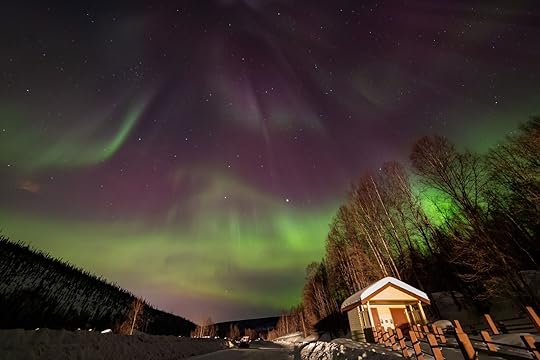
Photo: Kit Leong/Shutterstock
Dates: Usually around Dec. 21Location: Fairbanks, AlaskaTicket cost: FreeMost people visit Alaska in the summer, but astronomy buffs know it’s winter when the state shines — literally, in some cases. Alaska has some of the clearest skies in the country and Fairbanks is the epicenter of night sky viewing in the state, thanks to its reputation as the aurora borealis capital of the world. You can see the northern lights with some regularity for nine months out of the year, starting in September.
If you want to visit Fairbanks in winter, consider timing your visit with the Winter Solstice Festival. It’s an annual community event that celebrates the shortest day of the year and the return of longer daylight hours with events like evening light walks, a “Moose on the Loose” scavenger hunt, dog sled rides, a holiday bazaar, fireworks, and more. While you only need a few hours in town to check out the event, you’ll want to schedule a few days to spend in Fairbanks. You can fly into Anchorage and take the Aurora Winter Train to Fairbanks, then stay in an outdoorsy Airbnb. Alternatively, there are a few gorgeous resorts near the town designed to make aurora-viewing easier, like the heated clear domes of Borealis Basecamp, or the alpine chalets and cabins at Aurora Borealis Lodge. 
The Most On-Time Airline in Every Region of the World

It seems like delayed flights are par for the course when it comes to air travel after the COVID-19 pandemic — so much so, in fact, that the US Department of Transportation created first-of-their-kind regulations to ensure airlines refund passengers left stranded. It’s possible that additional rules could be introduced past that to compensate travelers for delays, even if their planes eventually take off.
However, with a Republican administration taking office in the US in early 2025, it’s likely that consumer protection won’t be as high of a priority as it has been during the Biden Administration. And that may mean that travelers in 2025 and beyond are again at the mercy of airlines to reschedule, reconnect, and redeliver them and their luggage when flights are delayed.
Fortunately, a new analysis of the Department of Transportation’s annual Air Travel Consumer Reports found each of the most on-time airlines in every region of the world. Sure, some delays are unavoidable — Denver, for example, is more likely to have delays due to de-icing planes than, say, Miami. But that doesn’t mean you have to settle for delayed flight, and when it comes to airline on-time performance, some airlines are better than others at landing you in your destination on time.

Some airlines are less likely to leave you waiting at a crowded gate than others. Photo: Best Photo Plus/Shutterstock
The 2024 On-Time Performance Review by Cirium found that the following airlines achieved the highest punctuality in their respective regions. Cirium is an analytics company that provides insights and analytics for the aviation industry. Because it collects real-time flight data, it has a wealth of information related to airlines’ on-time performance, delays, cancellations, and routes. Many airlines use Cirium and its data to help forecast demand and make route-planning decisions.
In the Cirium report, only some airlines are considered global, and those are the airlines highlighted for each region of the world. In order for an airline to be considered global, it must regularly serve at least three geographic regions, and be in the top 10 percent of airlines by annual flight and seat volume. That means some smaller airlines within each region may actually have a higher on-time performance than the “winners.” In those cases, both are highlighted below.The most on-time global airline in every global region
Latin America: Aeroméxico
View this post on Instagram
A post shared by Aeroméxico (@aeromexico)
Aeroméxico achieved the highest global on time performance, or OTP, in 2024. Nearly 87 percent of its flights arrived within 15 minutes of their scheduled time. The report credits that to the airline’s investment in new planes that are less likely to encounter maintenance issues. The average age of an AeroMexico plane is 7.1 years, compared to an industry average of around 11 years. It also credited the airline’s fleet expansion, as well as investments in high-tech programs that can predict and avoid potential weather disruptions before they happen.
Aeroméxico is Mexico’s flagship carrier and one of the leading airlines in Latin America. It’s based at Mexico City International Airport, flies to 23 countries, and is a member of the SkyTeam alliance.
However, in terms of carriers based in Latin America, Copa Airlines actually had the best on-time performance. In 2024, just over 88 percent of its flights arrived on time. It’s based in Panama and flies to several major cities in the US.
Africa: Fly SafairView this post on Instagram
A post shared by FlySafair (@flysafairza)
Though the report considers the Middle East and Africa one region, we think they’re worth highlighting separately. In Africa, Fly Safair took the top spot, with 93.82 percent of flights arriving with 15 minutes of their scheduled times. “FlySafair’s commitment to punctuality is no accident,” writes the report, “with FlySafair ranking as the most on-time regional carrier 11 out of 12-months in 2024 by Cirium.” Fly Safair doesn’t qualify as a global airline, but if it did, it would be the most on-time airline in the world.
Fly Safair is a low-cost airline based out of O.R. Tambo International Airport in Johannesburg, South Africa. It’s not part of any global airline alliance, though it does have booking agreements with major airlines like Air France, KLM, Qatar Airways, Emirates, Kenya Airways, and Ethiopian Airlines to allow for easy booking. It flies throughout Africa, including to many destinations popular for safari vacations.
View this post on Instagram
A post shared by Delta Air Lines (@delta)
Delta Air Lines led North American carriers with an on-time performance of just over 83 percent in 2024, securing the third position globally. Despite challenges, including a significant IT outage in July that disrupted operations, Delta held on to its title, having earned the same designation in 2023. The report credits an investment in new planes, as well as “comprehensive training programs, performance-aligned incentives, and a culture that prioritizes safety and punctuality” that allows employees to be as effective as possible. It’s actually an improvement from 2023, when 82.2 percent of Delta flights were considered on time.
Delta Air Lines is one of the largest airlines in the world, flying to 275 destinations in more than 50 countries. It’s a founding partner of the SkyTeam alliance and is based out of Hartsfield-Jackson Atlanta International Airport — the busiest airport in the world by passenger traffic.
United Airlines came in second with 81 percent of flights considered on time, and Alaska was third when it comes to airline on-time performance, at just over 79 percent.
Middle East: SaudiaView this post on Instagram
A post shared by Saudia (@saudi_airlines)
Saudia, the national carrier of Saudi Arabia, recorded an OTP of just over 86 percent in 2024. That gives it the number two spot when it comes to global airlines, though it’s actually only third among carriers based in the Middle East (as the first two aren’t considered “global” airlines). The airline’s on-time performance is credited to investments in infrastructure, including additional aircraft and additional seating to accommodate more flyers, which makes it it easier to adjust to move planes around when delays happen. It also added more flights and planes to its subsidiary low-cost airlines, Flynas and Flyadeal.
Saudia operates from its hub at King Khalid International Airport in Riyadh, Saudi Arabia, and flies to five continents. It’s a member of the SkyTeam Alliance.
Though it doesn’t qualify for the global rankings, Oman Air actually had the highest on-time performance for airlines based in the Middle East, at 90.27 percent. It flies to about 40 destination, though none are in North America, Latin America, or South America.
Asia-Pacific: Japan AirlinesView this post on Instagram
A post shared by Japan Airlines Global (@japanairlines)
Japan Airlines (JAL) was recognized as the leading carrier in the Asia-Pacific region for on-time performance in 2024, with 80.9 percent of flights arriving on time. That’s especially impressive given the massive cancellations and delays caused by two typhoons in August. Cirium credits the airline’s on-time performance to not just Japan’s culture — “the nation is globally renowned for its emphasis on timeliness, meticulous planning, and technological innovation,” the report writes— but also to the country’s overall investments in transportation and infrastructure, from trains to roads to airlines.
JAL is based at Tokyo Haneda Airport with a second large hub at Tokyo Narita Airport. It’s in the Oneworld Alliance and flies to 21 countries (or 66, if you count flights by airlines with whom it has a code-sharing agreement).
View this post on Instagram
A post shared by Iberia Express (@iberiaexpress)
Iberia Express took the top global spot in Europe, with an on-time performance of just under 85 percent. It’s the second year the airline has taken the top spot, which is especially impressive as it added additional flights to destinations like Marrakech and Edinburgh in 2024. The report credits the airline’s central location (hubbed in Madrid, Spain) as well as its high-tech modeling software, as being responsible for the solid performance statistics.
Iberia Express is owned by Iberia Airlines. It’s the flagship carrier of Spain and serves more than 130 airpots in 50 countries, with a focus on Spanish-speaking regions. It’s part of the Oneworld Alliance with British Airways, American Airlines, Qantas, and more. 
This Tech Could Make Airport Security Faster in 2025

Long lines at airport security checkpoints might soon be a thing of the past as the Transportation Security Administration (TSA) has announced that it will install facial recognition machines in more than 400 airports around the US.
At the time of writing, CAT-2 units (as the facial recognition machines are officially known) have only been deployed to 84 airports in the country, including at Denver International Airport (DEN), Spokane International Airport (GEG), Ted Stevens Anchorage International Airport (ANC), and Seattle-Tacoma International Airport (SEA) among dozens of others.
Facial recognition machines are set up at the start of the security screening process, before you enter the line to put your carry-on through the CT scanner and your body through the full-body millimeter wave scanner. And here’s how it works: Instead of having a Transportation Security Officer manually handle your ID and compare it to your face, you scan your ID on the machine’s reader and stand still while the machine takes a photograph of you. The CAT-2 unit then accurately compares the photo on your ID to the one that was just taken. If the photos match, you’ll be let through to the next step of the security process and your photo will be deleted immediately from the machine.
Using a CAT-2 units does not mean you can leave your ID at home. You absolutely need to have your physical ID with you for air travel. The CAT-2 units are able to read passports, ID cards, and driver’s licenses, but only select checkpoints can handle digital IDs for now.
Automating the process in hundreds of airport around the country will not only shorten security lines, but also make air travel is much safer by systematically stopping fraudulent ID holders and imposters in their tracks.
If you’d rather opt out of using facial recognition technology, you can ask to go through the regular procedure of having a Transportation Security Officer check your ID manually. You won’t lose your place in line, nor will you face any negative consequences because of it. However, know that facial recognition technology is not used for any other purpose than to verify your identity at the airport.
“Facial recognition technology is solely used to automate the current manual ID credential checking process and will not be used for surveillance or any law enforcement purpose. TSA uses facial recognition CAT-2 technology only to verify the identity of the traveler at the podium and make a determination for access into physical security screening,” the press release explains.
The US Customs and Border Protection (CBP) also uses facial recognition technology in hundreds of US airports to verify travelers who enter and exit the US, speeding up, and tightening the border crossing process. 
Eat and Stay in Style in Wilmington, NC and Island Beaches
 Eat and Stay in Style in Wilmington, NC and Island BeachesText by Jason Frye |
Eat and Stay in Style in Wilmington, NC and Island BeachesText by Jason Frye |Photo by Wilmington and Beaches
Imagine: You’ve just arrived in Wilmington and checked into the houseboat you’ll be calling home for a few days. You’re reluctant to leave your cozy digs, but you’re hungry, and tales of the monumental seafood tower at Seabird energize you.
Ready to kick off your Wilmington escape, you stroll through the downtown Historic District, stopping to snap photos of the sunset over the Cape Fear River before arriving for pre-dinner drinks at Concorde Espresso Bar. As soon as the cocktails arrive at your intimate firepit table, you raise yours in a toast — to the bites and sips ahead, to the beaches nearby, and to a stylish getaway where Wilmington shows you its very best.

This post is proudly produced in partnership with Wilmington and Beaches.
STANDOUT DINING Seabird
Wilmington’s food scene is no longer a locals-only secret. The word has spread, and foodies are flocking to this North Carolina coastal town to see what’s cooking. From acclaimed chefs and lauded restaurants to up-and-comers representing flavors from around the globe, Wilmington has what you’re craving, starting with more than its fair share of culinary virtuosos.
Seek out award-worthy meals…Chef Keith Rhodes, a Top Chef alum and multi-year James Beard Award nominee and semifinalist, brings his singular perspective to the plate at Catch. The fried seafood platter with jerk collards is Southern soul food at its finest, while the crispy skin salmon filet with stir-fried noodles showcases a dramatic flair. At Seabird, Chef Dean Neff, a James Beard Award finalist for “Outstanding Chef” nationwide and semifinalist for “Best Chef Southeast,” keeps his focus on seafood with a monumental tower featuring smoked tuna, pickled shrimp, oysters on the half shell, deviled eggs topped with caviar, and more. But don’t fill up too quickly — the whole menu, with dishes like swordfish schnitzel and crispy smoked catfish, will leave you dizzy.
Nearby, manna ave. 123 keeps it as local as possible while leveraging relationships with farmers and producers across the state to deliver meals that have earned it an AAA Four-Diamond Award every year since 2015. Pair the fresh catch with seasonal veggies or the steak and duck fat fries with a cocktail or bottle of wine from the award-winning cellar. Meanwhile, Chef Sunny Gerhart — yet another James Beard Award semifinalist — presents New Orleans-inspired fare at Olivero Kitchen + Cocktails, drawing on Italian, Spanish, French, Portuguese, and contemporary Southern traditions to create dishes like lasagna with octopus Bolognese and harissa-spiced pork cheeks.
manna ave. 123Feast Wilmington…trust your gut…If you have dietary restrictions or preferences to consider, no problem. Wilmington truly has something for everyone. Vegans and vegetarians should make a reservation at The Green House for high-end plant-based dining. For a more casual (but no less delicious) meal, stop by Sealevel City Vegan Diner, where the music is fun and the tempeh kimchi Reuben always pleases.
For a little taste of everything, mark your calendar for a spring visit to Wilmington. Food festivals come to town in March, with the Beer, Bourbon & BBQ Festival and Feast Wilmington, which some consider the city’s premier culinary event. Feast features a weekend full of gastronomic goodness, from evening parties on the pier to the grand tasting and closing brunch. If you can only catch one Feast event, make it Craft + Cuisine, which partners more than a dozen local breweries with chefs to produce delicious results.
Adventuring offshore? Let your culinary exploits whisk you away to a nearby uninhabited island with Epic Excursions. One of the most popular dining excursions begins with a private cruise and culminates in a seafood boil — either a casual standing affair or proper seated meal, depending on your mood. You can also book a steak dinner, organize a sunset cruise with cocktails, or boat to a tasting and tour at the Middle Sound Mariculture farm, where the world is quite literally your freshly shucked oyster.
…or go for the views.Of course, no culinary tour of Wilmington is complete without at least one meal enjoyed waterside. In Wrightsville Beach, grab a table over the sand and waves at Oceanic Restaurant if the weather’s right, or take a seat with big seaside views. Wherever you’re stationed, the menu here pleases with seafood classics and fresh bites on every plate. You can also keep it casual at Dockside Restaurant, where a beer and a burger or seafood taco served with a heaping side of Intracoastal Waterway views is the norm.
In Carolina Beach, Ocean Grill & Tiki Bar has coastal views, great food, and fun live music. Nearby, Stoked Restaurant serves local oysters steamed and on the half shell, grouper fingers, and peel-and-eat shrimp from a marina-side dining room that’s a haven for boat watching. If you’re craving something extra casual, grab a bite at The Tropical, a Miami-inspired spot on the Carolina Beach Boardwalk serving bowls, oversized egg rolls, and a hearty selection of vegan fare with ocean views on its rooftop patio.
One of the many joys of the Riverwalk is that downtown Wilmington has great waterfront dining, too. Snag a table on the sprawling porch at Elijah’s Oyster & Fish Camp or a spot on the terrace of The Pilot House for the classic alfresco experience — plus two delicious takes on a fried seafood platter. On Floriana’s beloved balcony, keep the views but swap the cuisine for mouthwatering Northern Italian bites like black gnocchi with lobster cream and rock shrimp. Or head south of the Riverwalk to see what the Cape Fear looks like from a different angle at Smoke on the Water, where you’ll love kicking back on the patio with a jalapeño-cucumber margarita and keeping the fried pickles coming.
FlorianaPhoto credits: Mallory Cash/Seabird, Sheridan Taylor/manna, and Wilmington and BeachesEXCEPTIONAL STAYS The Cove Dreamers Trailborn Surf & Sound C. W. Worth House
Those not lucky enough to call Wilmington home will need a place to stay while in town. Fortunately, there’s a whole host of accommodation options both downtown and at the nearby beaches. Some are so quaint or trendy they’ll have you thinking, “Wait, this is in Wilmington?”
From one waterfront to the next…With plenty of restaurants and entertainment nearby, The Cove Riverwalk Villas is a tempting place to base in Wilmington. The neighborhood of houseboats floats in the Port City Marina on a custom dock, and each two-bedroom unit is roomy enough for friends to gather for a pre-dinner snack and sip. Located right on the Riverwalk, you’ll be an easy stroll from downtown’s hot spots.
At Wrightsville Beach, Trailborn Surf & Sound (formerly Blockade Runner Beach Resort) oozes charm from its oceanfront location. Trendy rooms, excellent dining, and plenty of activities — from SUP yoga to scenic boat rides — make it a choice spot for a getaway. Plus, the folks at the hotel are happy to help arrange just about any local outing you can imagine, so take advantage.
Trailborn Surf & SoundC.W. Worth House…and everything in between.For peak charm, C.W. Worth House Bed & Breakfast — a winner of USA Today’s 10Best Bed & Breakfasts in America in 2023 and 2024 — offers a super stylish stay in an 1893 Queen Anne home. The building retains its antiquarian charm, while guest rooms are modern and welcoming.
Boutique hotels are another option, blending style, convenient locations, and cozy rooms. Try The Hive, an innovative property with self check-in, luxurious linens, and pet-friendly rooms in downtown Wilmington. Also downtown, DREAMERS by DW has taken over a gorgeous historic home and transformed it into a five-room inn with Insta-worthy rooms, suites, balconies, and porches near central concert venues, comedy clubs, nightlife, and restaurants.
If you’re coming to Wilmington with the whole crew — pets included — you can also go grand with an oceanfront vacation rental, be it a sound-side stay with a hot tub or a cozy coastal cottage.
Photo credits: John Stephenson/The Cove, Dreamers, Trailborn Surf & Sound, and Matt McGraw/C. W. Worth HouseARTSY ADVENTURES Greenfield Lake Amphitheater Live Oak Bank Pavilion
While you’re in town, make time to wade into Wilmington’s cultural scene. Switch between museum days and gallery nights, then get outside with everything from open-air concerts to strolls through Wilmington’s most cinematic neighborhoods.
Find out which celebs are performing…Wilmington is home to a pair of fantastic outdoor concert venues: Live Oak Bank Pavilion at Riverfront Park, which seats 7,300 and draws major artists from Phish to Jelly Roll and every genre in between, and Greenfield Lake Amphitheater, where acts like The Flaming Lips, Molly Tuttle, Steep Canyon Rangers, and other regional favorites perform to a crowd of only 1,200.
Big-name comedians also stop by Live Oak Bank Pavilion, while you can find up-and-coming acts like Nikki Glaser onstage at The Wilson Center. Meanwhile, the Dead Crow Comedy Room is a go-to for fantastic comics of all exposure levels. Add to that the long list of restaurants and bars in Wilmington that feature live music from local and regional acts, comedy shows, and open mics, and you have a town with a deep roster of live entertainment.
Live Oak Bank PavilionOne Tree Hill Naley’s Bench…and which ones filmed here.You may find yourself recognizing places around Wilmington as you explore town. That’s because the city, nearby beach towns, and the surrounding area have appeared in hundreds of TV shows and movies, including Dawson’s Creek, One Tree Hill, The Summer I Turned Pretty, films from the Halloween and Scream franchises, Iron Man 3, and more.
Take the Wilmywood Movie & TV Location Walk and snap a few pics in the real-life locations used in these films and shows.
Go for a cultural deep dive.If you’re visiting Wilmington toward the end of the month, schedule in a Fourth Friday Gallery Night and visit some of the galleries and working studios across town. Make sure to also check out Cameron Art Museum (CAM) for its thoughtfully curated exhibitions of North Carolina-inspired works by local artists.
Outside CAM, you’ll find a moving life-sized bronze sculpture, Boundless, depicting U.S. Colored Troops (USCT) who served in battle here during the Civil War. It’s the only realistic sculpture of USCT soldiers in public art across all of eastern North Carolina, and that’s only the beginning when it comes to the cultural and historic importance of this exhibit and outdoor park.
BoundlessPhoto credits: Alive Coverage/Greenfield Lake Amphitheater, Alive Coverage/Live Oak Bank Pavilion, Wilmington and Beaches, and Alan Cradick/Cameron Art MuseumFull of fine food and drink, stylish stays, and an arts-forward attitude, Wilmington and the nearby island beaches are something to be savored. Take your time immersing in the culture and community here, and you can bet you’ll come away already planning your next trip to experience the best of the Carolina coast.

This post is proudly produced in partnership with Wilmington and Beaches.
Where to Play, Eat, and Stay in Edmonton in Alberta, Canada

Let’s start with perception versus reality. The perception might be that Edmonton, Alberta — the northernmost city in North America with a population of over one million — would be shy on delivering all the things travelers are looking for in these days of immersive experiences. Let’s face it — this Canadian city flies under the radar.
Now, let’s explore the reality. Today’s Edmonton is not the Edmonton of decades ago. This city is throbbing with energy. A simple stroll through any of its neighborhoods delivers thought-provoking art, incredibly posh bakery creations, cheering crowds, and must-visit gift shops. Look a little deeper, and you’ll find an Indigenous experience that’ll make your heart light up, a leather-forward speakeasy hidden behind a bookcase, and a wall of sparkling gemstones inside a modern museum.
My most recent trip to Edmonton took place during a December cold snap when temperatures plunged to 15 degrees Fahrenheit. Then came the snow and wind. But none of that put a damper on anything I experienced in the city. It may have made it feel even more vibrant (although those whose explorations are best fueled by warmth and sunshine will appreciate that temperatures can push to 80 degrees in the summer). Whatever the season, here’s where to go for the best of Edmonton.
Things to do in EdmontonThe Neon Sign Museum
Photo: Ronnie Chua/Shutterstock
Sightseeing doesn’t get any easier than this. Simply look up at the red brick exterior warehouse wall to see the calling cards of the Princess Theatre, Georgia Baths, and, my personal favorite, the Canadian National Railway’s Freight Telegrams. It’s best to stroll by after dark to see this collaboration spearheaded by the city. The collection includes the first neon sign in Edmonton — Darling’s Drug Store in 1928 — and admission is free.
The Neon Sign Museum: 104 St NW, Edmonton, AB T5J 0K7, Canada
NHL Hockey at Rogers Place
Photo: Shel Zolkewich
I’ve been to a few National Hockey League games, and the arena atmosphere always gets my heart racing. But the vibe at the home of the Edmonton Oilers tops the list when it comes to fan fun. It’s most definitely a party atmosphere, with a brass band chiming in after goals and gifts being dropped by tiny drones into the stands.
In the expansive Ford Hall lobby area, a show-stopping public art installation called “Tsą tsą ke k’e” (“Iron Foot Place”) by the late Alex Janvier is a 45-foot diameter mosaic set in the floor. It highlights the colors of the sky and the land and mountains in the distance. The lighting above showcases the impressive architecture of the entire building.
With a capacity pushing 20,000, Rogers Place welcomes everyone. It’s fully accessible with elevator access to all seating levels, has a radio frequency assistive listening system, and offers sensory kits (as well as a quiet room) that can help reduce sounds and sights to a comfortable level.
Rogers Place: 10220 104 Ave NW, Edmonton, AB T5J 0H6, Canada
Explore 124th StreetView this post on InstagramA post shared by Bearclaw Gallery (@bearclawgallery)
It’s all about independence here on 124th Street. It’s plain to see in the murals that decorate exterior walls and the stride of the people who call this neighborhood home. We might even call it swagger. There are galleries galore, including the Bearclaw Gallery that features First Nations, Métis, and Inuit artists. It’s part of a Gallery Walk that packs it all into two tight blocks.
There are dozens of specialty fashion, accessory, and décor retailers on the street, including The Makers Keep, a collective that showcases made-in-Alberta goods that make perfect souvenirs.
And then there’s the food, anchored by Duchess Bake Shop, which has a perpetual line-up out the door during business hours. In 2015, the shop cracked Buzzfeed’s “23 Bakeries Around The World You Need To Eat At Before You Die” list, and the buzz hasn’t stopped. One bite into a classic croissant, and you’ll know why.
124th Street: 124 St, Edmonton, AB T5N 1R1, Canada
Royal Alberta Museum
Photo: Shel Zolkewich
It’s big, bright, and one of the most beautifully designed museums I’ve visited. First opened in 1967, the museum moved to its new home in 2018, where the first level is dedicated to human history, a massive children’s section, and a bug museum. There’s also the Museum Zone where the fascinating work of conservation happens in plain sight. The second level is all about natural history, and it’s there that the gem and mineral collection made my eyes sparkle. Rocks, minerals, meteorites, gems, and fossils from over 80 countries are on display in quantities that would impress diehard geology enthusiasts.
Royal Alberta Museum: 9810 103a Ave NW, Edmonton, AB T5J 0G2, Canada
Métis Crossing
Photo: Shel Zolkewich
A 90-minute drive northeast of Edmonton puts you near Smoky Lake, where it’s time for a deep dive into Indigenous culture at Métis Crossing. One of Canada’s three Indigenous peoples, the Métis are the result of post-contact unions between European fur traders and First Nations women. I hopped into an SUV for the Visions, Hopes, and Dreams Signature Experience here, where my group saw captive herds of elk and bison and Percheron horses as coyotes and crows crisscrossed our path. Along the way, we learned about the roles these animals play in Métis culture, specifically the community bison hunts that came with a seriously strict set of rules. At nightfall, I settled into my skywatching dome (where heated floor made it oh-so-cozy) and dreamt about eggs Benedict on bannock in the bistro the next morning.
Métis Crossing: 17339 Victoria Trail, Smoky Lake, Alberta, T0A 3C0, Canada
Indigenous Peoples Experience at Fort Edmonton
Photo: Shel Zolkewich
My group was joined by Mautouyipiyaki, or Speaking Sacred Words Woman, for our off-season tour of this space inside Fort Edmonton Park. The Elder was joined by Evert Poor, the park’s Indigenous Narratives Coordinator, and together, they took us on an immersion journey like no other. That’s how things work here — Indigenous people always lead the way, and this collection of stories and images came together after deep conversations. The space itself is a masterpiece of architecture and design, making visitors feel warm and embraced. The stories it holds are sometimes difficult but always authentic, coming directly from First Nations and Métis peoples. A standout of the space is the Métis cabin where a table is laid out with recipes and cookware, and the walls are adorned with family photos.
Indigenous Peoples Experience: Fort Edmonton Park, 7000 143 St NW, Edmonton, Alberta, T6H 4P3, Canada
Where to eat in Edmonton
Photo: Shel Zolkewich
Start your day at Tiramisu Bistro with the applewood smoked bacon crepe slathered in Hollandaise sauce with a vanilla latte on the side. Pop into the bakery next door, Lift Me Up, for a sweet treat, then saunter down the street and pick up snacks for later at Destination Doughnuts. I recommend the crème brulee and the white chocolate coconut. For lunch, Campio Brewing Company’s big menu is heavy on snacks and appetizers before getting serious with Detroit deep-dish pizzas and hefty burgers (plus a merch corner for easy souvenirs).
For a choose-your-favorite dinner, visit EPIC Market & Food Hall where five international cuisines dish out everything from a green papaya salad to bacon poutine. The two-level space has a bar on each floor with plenty of seating. It’s a good idea to make a reservation at RGE RD since its focus on local makes it a popular spot. Start with the gouda and potato perogies, a Scotch egg, and wood-oven baked bread. The bison main was the best I’ve ever had.

Photo: Shel Zolkewich
Celebrating Indigenous plates, Bernadette’s is an ode to grandmothers everywhere, where the menu is all about comfort. The creations arrive on vintage Royal Alberta china — Old Country Roses pattern, to be specific. Settle in under the stunning mural for ocheshishak (fried rice balls), elk carpaccio, and a sweet Saskatoon berry tart.
Where to stay in EdmontonHome base for my recent Edmonton visit was the posh, yet completely practical, JW Marriott Edmonton ICE District, where location is everything. It’s connected to Rogers Place, making it a favorite for visiting athletes and entertainers. Among the highlights of this hotel is its signature handcrafted ice menu with six options for your choosing, delivered right to your door, free of charge. Will it be strawberry and blueberry or green olive and celery? And then there’s Alchemy Bar, a secret speakeasy concealed behind a bookcase on the fifth floor. Inside, buttery leather sofas and low lights welcomed me for a paper plane, a twist on a whisky sour.
JW Marriott Edmonton ICE District: 10344 102nd Street, Edmonton, Alberta, T5J 0K9, Canada
Getting around Edmonton
Photo: oasisamuel/Shutterstock
Like most Prairie cities, Edmonton is spread across the landscape, so getting from neighborhood to neighborhood is best done by vehicle or public transportation. But once you’re where you want to be, walking is a breeze. Edmonton Transit Service provides bus and light rail transit (LRT) services around the city. 
7 Archaeological Digs You Can Join in 2025

It’s not a coincidence that “vacation” rhymes with “excavation” — archeology-focused travels makes for some of the best trips you can take. Not a simple guided visit of Italy’s Pompeii or a quick tour of Hegra in Saudi Arabia, however, but a trip during which you can get down and dirty by actually partaking in an active archeological or paleontological dig. Because even if you don’t have a PhD in the field, you can join a dig to uncover ancient human remains, structures, artifacts, or even the skeletons of dinosaurs, as long as you’ve got the patience, physical health, schedule, and budget to do it.
The Archeological Institute of AmericaThe Archeological Institute of America organizes dozens of expert-led trips to active digs around the world every year, but it also offers those who are keen to partake in digs the chance to do so by advertising a multitude of worldwide fieldwork opportunities on its website, including volunteer and fee-based ones. Of the numerous no-skills-required digs available, the three listed below are bound to deliver unforgettable experiences.
Human Ancestors Dig in South AfricaView this post on InstagramA post shared by Ancient Odysseys (@ancientodysseys)
Where: Sterkfontein and Kromdraai Caves in The Cradle of Humankind in South Africa
Dates: Two 13-day sessions are available in 2025, May 3-16 and September 6-19
Price: Starting at $8,199
This trip, organized by Ancient Odysseys in partnership with GENUS Paleosciences, will take place in The Cradle of Humankind, a paleoanthropological site located near Johannesburg, South Africa. It’s a fieldwork opportunity for those interested in the very origins of humankind and human evolution, as the site is rich with human ancestor fossils, as well as the remains of ancient habitations, flora, and fauna.
Week one on site will be spent at Kromdraai Cave, excavating, sampling, and cleaning finds alongside renowned archeologist José Braga. You will work for six days in a row from 8 AM to 4 PM, and all the tools will be provided. During week two, you will prepare fossils and sort microfauna under the supervision of Matt Caruana at Sterkfontein Cave.
When not working on site, you will visit the Fossil Vault at the Evolutionary Studies Institute at Wits University, and go on a two-day safari to see Africa’s Big Five.
Learn More/BookArtifacts dig in French Polynesia
Tahuata island, part of the Marquesas in French Polynesia. Photo: username/Shutterstock
Where: Tahuata, the Marquesas, French Polynesia
Dates: June 21 – July 27, 2025
Price: $8,700
This five-week fieldwork program, run by the Andover Foundation for Archaeological Research (AFAR), combines paradisiacal landscapes and the opportunity to learn more about the fascinating Marquesan culture through archeology. The dig, located on the remote island of Tahuata in the Marquesas, hopes to unearth Marquesan art and artifacts that will help archeologists understand the daily life of the Marquesan people centuries ago. The findings will be displayed in the Te Ana Peua, the first community-based archaeology museum in French Polynesia. Under the direction of University of Hawai‘i archaeologist Professor Barry Rolett, you will partake in site surveys and design and create new exhibits for the museum.
Learn More/BookMegafauna Dig in Australia
Photo: Chris Ison/Shutterstock
Where: Eulo, Queensland, Australia
Dates: August 3-11, 2025
Price: Starting at $2,720.
This fieldwork opportunity, run by Ancient Odysseys in partnership with Australian Geographic Travel, will take place in Eulo, a paleontological dig in Australia’s Outback. During the five days on site, starting at 7:30 AM each morning, you will excavate and collect fossils of extinct megafauna that lived 150,000-50,000 years ago, as well as do some lab work at the Eromanga Natural History Museum. You will receive all the instructions and tools necessary to make the most of your time on site.
Learn More/BookNew Scientist Discovery ToursThe travel branch of the science and technology magazine New Scientist, runs science-inspired tours, cruises, and expeditions all over the world, including trips to archeological and paleontological sites where you can join in on the excavating fun.
Dinosaur hunting in the Gobi desert, Mongolia
The Flaming Cliffs in the Gobi Desert. Photo: Evgeniyqw/Shutterstock
Where: Mongolia
Dates: August 16-31, 2025
Price: $9,630
During this 15-day trip around Mongolia, you will prospect for dinosaur fossils at various remote sites around the Gobi Desert under the guidance of paleontologist David Home and specialists from the Mongolian Institute of Paleontology. The sites you’ll visit are rich in fossilized remains, therefore, your chances of unearthing the fossils of ancient creatures of all sizes are extremely high. You will even get to visit and prospect at Flaming Cliffs, where the first ever dinosaur eggs were found in 1922. For the majority of the trip, you will stay in comfortable tents in the middle of nature, like a real explorer would.
Learn More/BookMycenae and Peloponnese archaeology, Greece
Photo: Irina Rogova/Shutterstock
Where: Peloponnese Region, Greece
Dates: September 29 – October 7, 2025
Price: $4,320
This is the ideal trip for an amateur archeologist to get the hang of working on a dig. On day three of this in-depth, behind-the-ropes tour of the most impressive Mycenaean sites of the Peloponnese, you will partake in a day-long, on-site archeologist training under the supervision of Professor Christofilis Maggidis, President of the Mycenaean Foundation, and his team of archaeologists. At a simulated one-acre dig in Mycenae, and in the lab, you will learn the steps, techniques, and technologies used by professionals to dig a site, as well as date, interpret and record findings. At the end of the day, you will receive the Mycenaean Foundation’s ATREUS Fieldwork Certificate.
Learn More/BookEarthwatch InstituteEarthwatch Institute is an environmental non-profit that connects travelers with scientists via citizen citizen science trips, including archeological fieldwork, wildlife survey work, and more.
Discovering Ancient Societies in PortugalView this post on InstagramA post shared by Earthwatch (@earthwatch)
Where: Muge, Portugal
Date: Multiple seven-day trips available starting on July 29 and ending on September 13, 2025
Price: Starting at $3,950
This seven-day fieldwork opportunity, which will take place in the small town of Muge in Portugal’s Tagus Valley, will allow amateur archeologists to excavate and sift for evidence of human activity, including human remains, bone tools, ornaments, shells, and more. You will also partake in lab work to process and analyze unearthed artifacts. The mission of the dig is to help archeologists better understand the population transition from hunter-gatherers to farmers and herders that happened in Central Portugal 8,000 years ago.
Learn More/BookUnearthing Ancient History in TuscanyView this post on InstagramA post shared by Earthwatch (@earthwatch)
Where: Populonia Archaeological Park, Italy
Date: Multiple seven-day and 13-day trips starting on May 4 and ending on October 17, 2025
Price: Starting at $3,100
The goal of this expedition is to help archeologists unearth artifacts that will help them understand better what life was like in the industrial Populonia area under Roman rule. During your time on site, you will dig for artifacts, clean them, record them, study them, and learn how to preserve them. You will also learn how to map digging sites, an important skill in archeology and paleontology. 
Matador Network's Blog
- Matador Network's profile
- 6 followers



